Star Trek: First Contact
Written by Rick Berman & Ronald D. Moore & Brannon Braga
Directed by Jonathan Frakes
Original release date: November 22, 1996
Stardate: 50893.5
Author’s Note: I had debated doing this rewatch the same way I did Star Trek IV: The Voyage Home two years ago, to wit, as a liveblog. Or I could do it the same way I did all the episodes of TNG, with the categories and stuff. Unable to decide, I put it to readers of my blog, who voted 4.5 to 1 in favor of doing it rewatch-style over a liveblog. The people have spoken! So, herewith, the rewatch of the second TNG movie….
Captain’s Log: Picard awakens from a nightmare about his assimilation by the Borg six years earlier to learn from Admiral Hayes that a single Borg cube has destroyed the colony on Ivor Prime. Hayes is mobilizing a fleet to meet the cube, but the shiny new Enterprise-E—which has been in service for a year now—won’t be part of it. They’re being sent to the Neutral Zone, even though there’s been no unusual activity on the Romulan border for nine months, because Hayes doesn’t trust Picard in proximity to the Borg.
The Enterprise listens in on the battle, including the Borg themselves making the same announcement that Locutus made at the end of “The Best of Both Worlds, Part I.” Unable to stand listening to it any longer, Picard turns the audio feed off—and then orders Lieutenant Hawk to plot a course for Earth. When he gives anyone in the crew a chance to note their discomfort with Picard’s disobeying of Starfleet’s orders for the record, Data speaks for everyone when he says, “To hell with our orders.” (Gotta love that emotion chip…)
They arrive to find a fleet of Starfleet ships getting their asses kicked—including the Defiant, with Worf in command. After being told that shields and weapons are offline, Worf orders ramming speed, figuring to take the Borg out the old-fashioned way, but then the Enterprise rescues them. Picard then orders the fleet to target a section of the Borg ship that does not appear to be a vital system—but it seems to be enough, as the concentrated fire on that one section destroys the cube.
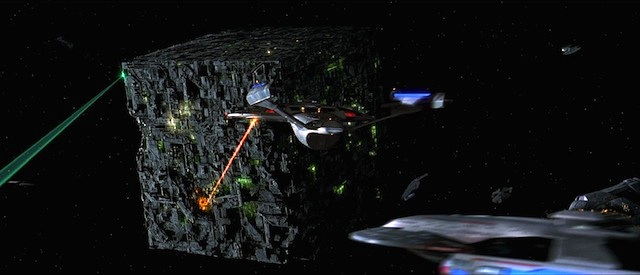
Crusher escorts one of the patients beamed over from the Defiant who insisted on coming to the bridge: Worf. Picard happily asks him to take over tactical, after assuring him that the Defiant is intact and salvageable. (“Tough little ship,” Riker comments, to which Worf retorts, “Little?”)

A sphere ejected from the cube before it was destroyed and is heading for Earth while creating a temporal vortex. The Enterprise is caught in the vortex’s wake—and then the sphere disappears. Earth changes before their eyes, and Data reports that the planet has been completely assimilated by the Borg—in the past. Being caught in the vortex’s wake has spared the Enterprise from the timeline changes, and Picard orders Hawk to fly into the vortex before it collapses so they can fix whatever damage the Borg did in the past.
Cut to April 2063, Montana. Dr. Zefram Cochrane and his assistant, Lily Sloane, are stumbling home from the bar. Cochrane wants one more round, but Sloane doesn’t wish to fly into space with a drunken pilot. Cochrane replies that he sure as hell isn’t going up there sober.
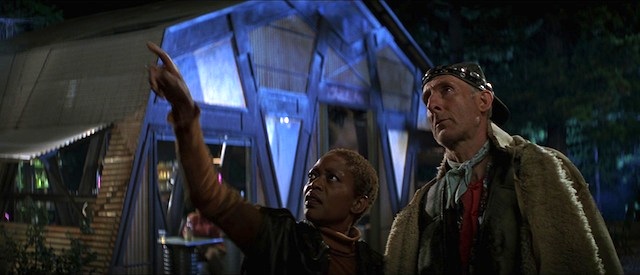
They’re interrupted by an orbital bombardment from the Borg. The Enterprise shows up in space with Worf destroying the sphere with quantum torpedoes. Once Data confirms the date—the 4th of April 2063, the day before Cochrane took the first human ship with faster-than-light travel out and humans made first contact with alien life—the crew realizes the Borg’s plan. If they stop first contact, they stop the Federation from forming.
Picard, Data, Crusher, and a security team beam down in contemporary clothing to assess the damage, since sensors and shields are down after going through the vortex. The silo where the Phoenix, Cochrane’s ship (a retrofitted nuclear missile), is docked is filled with corpses. The ship itself is damaged, but repairable, especially since the Enterprise has the ship’s specs in their library computer.
Sloane fires on them with a small rifle. When Picard tries to convince her that they’re there to help, she replies, “Bullshit!” and keeps firing. Luckily, Data’s bulletproof, but when he tries to explain to her (once her clip is empty) that they come in peace, she collapses from her wounds.
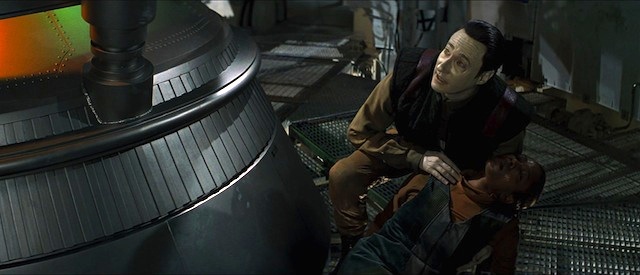
Crusher has to treat her for radiation sickness in sickbay, promising to keep her unconscious. She beams back with Sloane, while La Forge beams down with an engineering team to repair the Phoenix. (La Forge leaves his deputy chief engineer, Porter, in charge and tells him to look at the environmental controls, as it’s getting a bit hot. That isn’t at all ominous.) Riker and Troi also beam down to aid in the search for Cochrane, who needs to be located so he can fly the Phoenix the following day and keep history on track.
On the Enterprise, Porter and another engineer try to figure out what’s wrong with the environmental controls. Both of them find Borg in the Jefferies Tubes and are quickly killed. On the surface, Picard senses this and immediately beams back with Data, leaving Riker to supervise the search for Cochrane and the repairs to the Phoenix.
Worf and Hawk report the precise atmospheric changes, which Picard reveals matches the atmosphere on a Borg ship. Some Borg had to have beamed over before the sphere was destroyed while shields and sensors were down. Within moments, all communications with the away team are cut off, and power starts being rerouted to main engineering. Crusher and Ogawa manage to evacuate sickbay—using the Emergency Medical Hologram as a reluctant distraction (“This isn’t part of my program; I’m a doctor, not a doorstop”)—though they lose Sloane in the confusion.
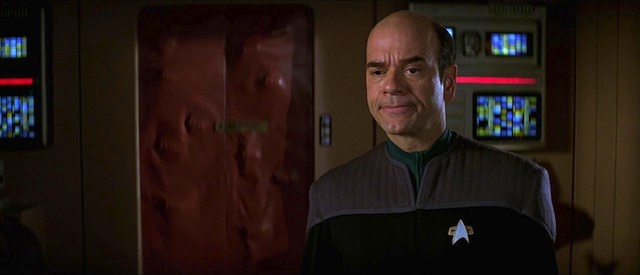
The Borg have taken over engineering, intending to make it their new hive. Picard (who, along with Data, has taken the time to change back into uniform despite the crisis) instructs his people to, if they make it into engineerng, aim for the plasma coolant tanks, which will destroy organic matter.
On the surface, Troi has found Cochrane in the bar. When Riker catches up to them, they are both exceedingly drunk. Troi thinks that they need to tell Cochrane the truth, as he isn’t buying their cover story. (She also declares that, in her professional opinion as ship’s counselor, Cochrane is “nuts.”)

On the Enterprise, Picard and Data lead one team through the corridors of deck 16, the Borg’s new home base, while Worf leads another. The corridors of the deck are being changed into a Borg-like configuration, and they find alcoves with inactive Borg in them. The two teams converge at the entrance to main engineering, but they can’t get in—and their attempts to get in awaken the nearby Borg.
The subsequent firefight is one-sided, as several crewmembers fall—including Data, who is dragged into engineering. Picard orders a retreat and regroup on deck 15. Pausing along the way to fire his phaser on a crewmember who’s being assimilated (his version of “helping” the poor bastard), Picard crawls through a Jefferies tube only to be ambushed by Sloane. She gets his phaser and orders him to get her out of there.
Data has been captured by the Borg Queen. The android encrypted the Enterprise computer before the Borg could gain access to it, and they start drilling (literally) into him in the hopes of getting the code.
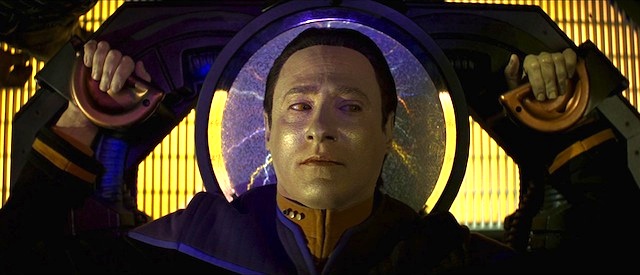
Riker—with some help from La Forge turning Cochrane’s own telescope toward the orbiting Enterprise—convinces Cochrane that he has to make the warp flight the following morning. Cochrane struggles with it (“You people are all astronauts on some kind of star trek…”), but agrees to assist La Forge with the repairs and make the flight.
The Borg have assimilated decks 26 through 11, but have stopped at 11. Worf isn’t sure why, as there’s nothing vital there. Meanwhile, Picard takes Sloane to a cargo bay and shows her Earth. That rather stuns her, as she thought she was still in Montana. Reluctantly, she hands Picard back his phaser—at which point he reveals that she would have vaporized him if she’d fired. She says, “It’s my first ray-gun” by way of apology. Picard takes her through the corridors. She’s overwhelmed by the sheer size of the Enterprise, especially given how difficult it was for her to scrounge enough titanium for the Phoenix’s itty-bitty cockpit. They encounter several Borg (“Sounds Swedish”), whom Picard lures to the holodeck, where he actives a program called “The Big Goodbye.” It’s, of course, a Dixon Hill program and, once again, Picard takes the time to change clothes (though he looks awesome in the trenchcoat, white tuxedo, and hat). He finds a character whom he knows has a Tommy gun and uses it on the two Borg who chase after them into the holodeck. He removes the neural processor from one of the Borg corpses (which was a crewmember, Ensign Lynch, to whom Picard barely gives a second thought) and examines it with his tricorder.
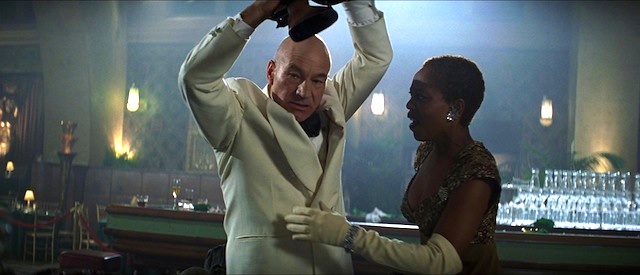
Data and the Borg Queen engage in a debate on the subject of evolution, perfection, and assimilation. The Borg are grafting human skin onto Data, and the touching of that skin stimulates him. At one point, Data almost escapes, but the Borg stop him by the simple expedient of slashing his new skin, which almost cripples him, as the sensations are overwhelming. But he can’t bring himself to remove the new skin, either. The Queen then tries seducing him.
Cochrane is incredibly uncomfortable with the hero worship he’s getting from the Enterprise crew. The tipping point is Barclay fangoobering him and La Forge telling him about the statue that will be erected in his honor (and also that he went to Zefram Cochrane High School), and Cochrane runs away. Riker and La Forge catch up to him, but he refuses to go back (“I don’t want to be a statue!”). Riker finally just shoots him on stun and has done with it.
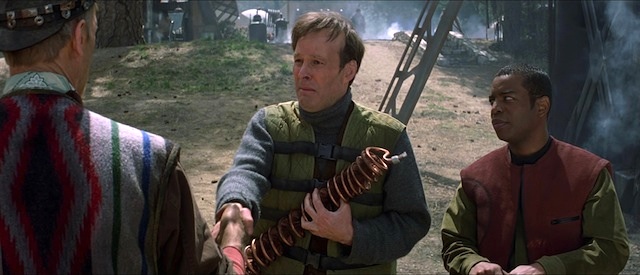
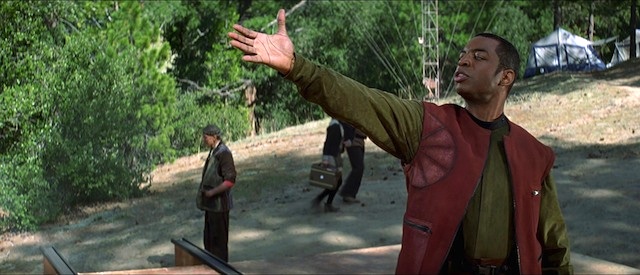
Picard and Sloane make it to the bridge. The Borg are planning to repurpose the deflector dish—which is on deck 11—into a subspace beacon that will summon this century’s Borg to Earth. They have to destroy the deflector dish, and to do so, Picard, Worf, and Hawk go EVA. While the Borg construct the beacon, the trio go to the three maglock releases to manually remove the dish. Unfortunately, their actions alert the Borg. Hawk shoots one into space, but they adapt to the phasers. Picard fires on the floor beneath one, shooting him off into space, while Worf uses his mek’leth on one. Another attacks and assimilates Hawk (whom Worf is forced to knock out into space to save Picard), but they are able to release the deflector dish, which Worf then destroys (“Assimilate this!”).
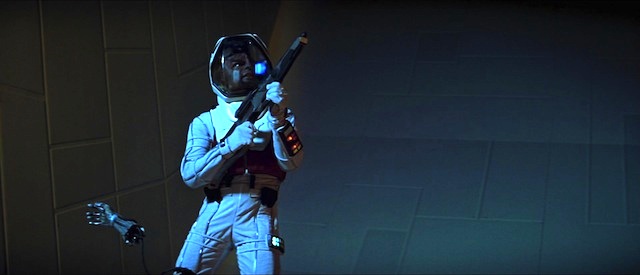
Cochrane—hung over as hell—is ready to fly. Riker and La Forge serve as his copilots, since Sloane is stuck on the Enterprise (presumably the third seat was for one of the people who died in the initial Borg attack), while Troi runs mission control. Cochrane is concerned that he’s forgotten something, and then remembers—it’s his music. The Phoenix takes off to the dulcet tones of Steppenwolf’s “Magic Carpet Ride” (at least until Riker, the big stinky, tells him to turn it down).
The Borg have adapted to every weapons modulation. Worf and Crusher both recommend that they activate the autodestruct, but Picard refuses, insisting they stand and fight. Worf accuses Picard of the very thing that Hayes cited as the reason for keeping the Enterprise away from the Borg in the first place: letting his personal feelings about the Borg get in the way of what must be done. Picard responds by calling Worf a coward and kicking him off the bridge, then retreats to the observation lounge. Sloane is aghast, especially since Worf and Crusher then follow Picard’s orders.
Sloane confronts Picard, accusing him of being Captain Ahab chasing his whale. He insists it’s not about revenge, it’s about saving humanity, to which Sloane replies succinctly: “Bullshit.” Picard rants and raves like a crazy man, and only after he hears himself does he realize how far gone he is.
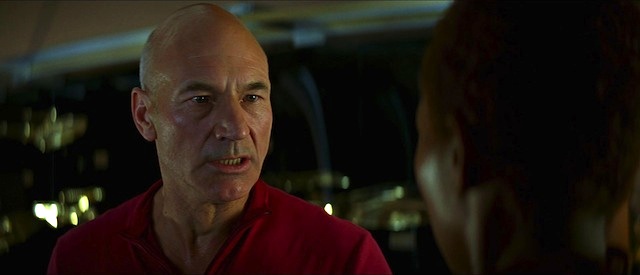
Picard returns to the bridge and gives the order to evacuate and start the autodestruct. He apologizes to Worf, and then learns that Data is still alive in engineering. After giving Sloane a note for Riker, Picard heads for engineering while the Enterprise escape pods all head for Earth. He’s got less than fifteen minutes to rescue Data, just as Data helped rescue him back when he was assimilated.
The Borg Queen confronts Picard, trying to bargain for Data’s release by agreeing to be Locutus again. But Data—who has now had a third of his face replaced with organic skin—refuses the freedom the Queen grants him when Picard makes the offer. Data then deactivates the autodestruct and releases the encryption on the Queen’s order. She instructs Data to destroy the Phoenix—but the torpedoes he fires miss the mark. Data then turns to the Queen, says, “Resistance is futile,” and smashes the plasma coolant, which floods the engineering floor. Picard quickly climbs to higher ground, and the Queen follows—but Data (his skin having been boiled off by the coolant, leaving internal circuitry of his head and arm exposed) grabs her and brings her back down to the floor. She’s destroyed by the coolant, which in turn deactivates every Borg on the ship.
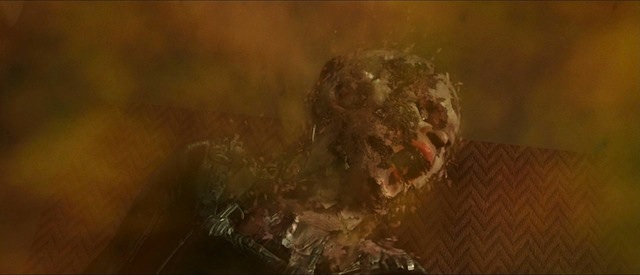
Meanwhile, the Phoenix successfully goes to warp and makes it to the edge of the solar system in a few minutes. (Cochrane says “Engage” upon activating the warp drive, prompting a big smile from Riker and La Forge.)

After the Phoenix returns to Earth, a large ship lands in Montana. An alien being with pointed ears—a Vulcan—steps out of it and greets Cochrane with a familliar hand-gesture, while Picard, Riker, Troi, Crusher, and La Forge observe from the background. Picard says goodbye to Sloane, and the Enterprise is able to re-create the vortex and head home. Meanwhile, Cochrane introduces the Vulcans to whiskey and rock and roll, thus showing the aliens just how civilized humanity is….
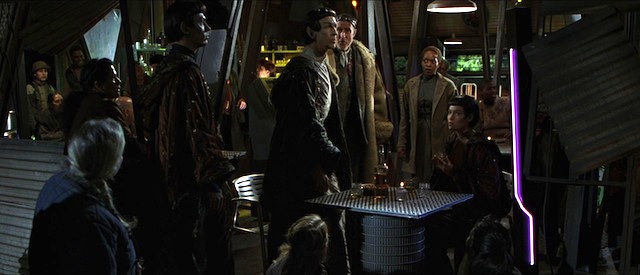
Thank You, Counselor Obvious: If you want to get Troi drunk, give her tequila.
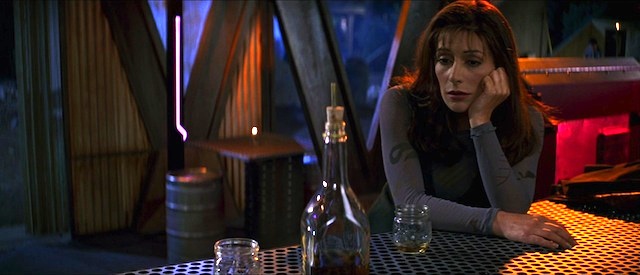
There is No Honor in Being Pummeled: Worf is nauseated by being in zero-gravity, but manages to kick some Borg ass on the deflector dish in any case. Since Michael Dorn had joined the cast of Deep Space Nine by this time, his appearance in TNG movies would need to be explained. This time ’round, it was fairly easy, as Deep Space 9 has a vessel attached to it, the Defiant, which was originally designed to combat the Borg, and one of Worf’s duties on the station is overseeing it. So having that ship be part of the armada is very fitting.
Composer Jerry Goldsmith also uses the Klingon leitmotif he himself created way back in Star Trek: The Motion Picture several times in the film when Worf is on camera, starting with the scene on the Defiant.
If I Only Had a Brain…: Since Generations, Data has learned to turn off the emotion chip. He also assures the Borg Queen that he is still fully functional, and—based on the time span he gives the Queen regarding how long it’s been since he used the multiple techniques he’s been programmed with—he hasn’t gotten laid since Yar seduced him way back when. (Poor Jenna D’Soura never got to take full advantage of that subroutine…) He also admits to Picard that he considered the Queen’s offer for 0.68 seconds, which is an eternity for an android.
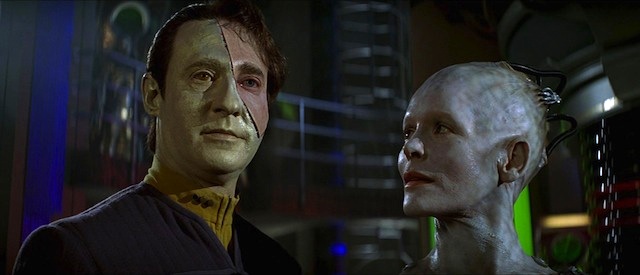
No Sex, Please, We’re Starfleet: Cochrane hits all over Troi in the bar. When Riker shows up, he asks her if he’s a friend of hers. After she says yes, then he asks if it’s her husband. She says no, he grins a mile wide and says, “Good!” Just wait two more movies, there, fella….
What Happens on the Holodeck Stays on the Holodeck: Picard lures some Borg onto the holodeck while it’s running a Dixon Hill program. He does this primarily to make use of Tommy guns, since the Borg never developed a defense against bullets. Picard disengaged the safeties, and again I say, why is it even possible to disengage the safeties? (Amusingly, “Dix” has a lady friend on the holodeck named Ruby. In earlier drafts of the script, the character that eventually became Lily Sloane was named Ruby and was supposed to be a love interest for Picard.)
In the Driver’s Seat: Lieutenant Hawk flies the ship, at least until he’s assimilated while assisting Picard and Worf with the removal of the deflector dish. Worf is forced to shoot him, giving this film its very own redshirt….
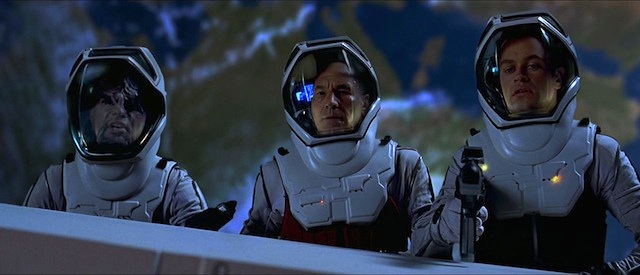
I Believe I Said That: “Someone once said, ‘Don’t try to be a great man, just be a man and let history make its own judgments.’”
“That’s rhetorical nonsense. Who said that?”
“You did. Ten years from now.”
Riker hoisting Cochrane on his own petard.
Welcome Aboard: The biggest “guest stars” are James Cromwell as Zefram Cochrane, Alice Krige as the Borg Queen, and Alfre Woodard as Lily Sloane.
Cromwell had previously been on TNG’s “The Hunted” and both parts of “Birthright,” as well as DS9’s “Starship Down.” He’ll reprise the role of Cochrane in Enterprise’s “Broken Bow” and, after a fashion, “In a Mirror, Darkly, Part I.” The character of Cochrane previously appeared in the original series’ “Metamorphosis,” played by Glenn Corbett.
The Borg Queen will appear again in several Voyager episodes, but Krige would only reprise the role in “Endgame.” When the character appeared in “Dark Frontier” and the “Unimatrix Zero” two-parter, she was played by Susanna Thompson.
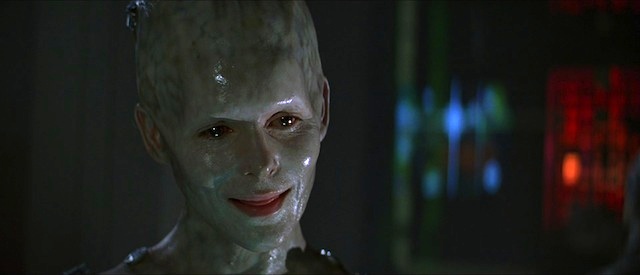
Woodard is a longtime friend of both Jonathan Frakes and LeVar Burton, and in fact Frakes refers to her as his godmother. Frakes, the film’s director, was the one who pushed to cast her in the role of Sloane.
Dwight Schultz and Patti Yasutake reprise their TNG roles as Barclay and Ogawa, respectively. Robert Picardo makes a cameo as the Enterprise’s Emergency Medical Hologram; Picardo was a regular on Voyager as that ship’s EMH, which was pressed into permanent use due to the ship being stranded with no medical personnel. Another Voyager star, Ethan Phillips, has an uncredited appearance at the maître d’ on the holodeck. Michael Horton plays a security officer; he’ll be back in Insurrection as the ship’s tactical officer and be named Daniels. Jack Shearer plays Admiral Hayes, a role he’ll reprise twice on Voyager (in “Hope and Fear” and “Life Line”), which means that he must have survived the destruction of his ship. And Neal McDonough—who has gone on to a fine career—plays the ill-fated Lieutenant Hawk.
Trivial Matters: This film is a sequel to “The Best of Both Worlds,” and indeed reads as though no other Borg stories ever happened between that episode and this movie. It’s also, in many ways, the prequel to the series Enterprise, which picks up a century after the events portrayed here and shows the long-term consequences of humanity’s first contact with the Vulcans.
This is the first appearance of the Sovereign-class U.S.S. Enterprise, NCC-1701-E. It’s the sixth Starfleet vessel by that name, and at this point all six have been seen onscreen: the original (Constitution-class) was first seen in “The Cage,” with A debuting in Star Trek IV: The Voyage Home, B (Excelsior-class) in Star Trek Generations, C (Ambassador-class) in TNG’s “Yesterday’s Enterprise,” and D (Galaxy-class) in TNG’s “Encounter at Farpoint.” The ship—indeed, this class of ship—was only seen in this and the subsequent two films. Despite the many dozens of types of ships seen on DS9 over the years, a Sovereign-class vessel was never among them.
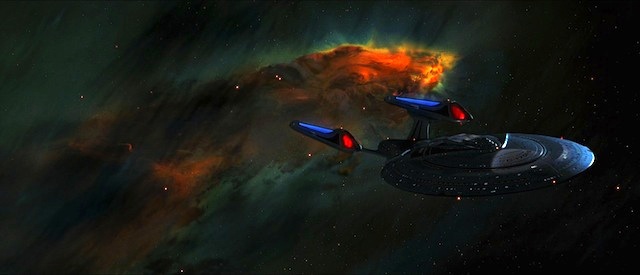
This movie went through several title changes in pre-production, starting with an early draft called Star Trek Renaissance, in which the Enterprise travelled back in time to medieval Italy. Star Trek Resurrection was the working title for some time, until Alien Resurrection was announced, at which point several alternate titles were suggested (Destinies, Future Generations, Generations II, Regenerations, Borg) until they settled on First Contact.
Two years after the release of this film, which has thematic resonances with and quotes from Moby-Dick, Sir Patrick Stewart would actually play Captain Ahab in a USA miniseries adaptation of the Herman Melville novel, which also featured Gregory Peck and Ted Levine.
Like all the Trek movies, this film was novelized. It was written by J.M. Dillard, who also novelized The Final Frontier, The Undiscovered Country, and Generations, and would go on to do the same for Insurrection and Nemesis. John Vornholt also wrote a young adult novelization and scripted the comic book adaptation published by Marvel.
Your humble rewatcher addressed why Worf was the only familiar face assigned to Deep Space 9 on board the Defiant in the eBook Enterprises of Great Pitch and Moment, part of the Slings and Arrows miniseries. (Basically, Starfleet didn’t trust Sisko against the Borg any more than they did Picard, and so they deliberately assigned people who’d only served on the station for a year or less to the Defiant. Worf was the only exception due to his past experiences fighting the Borg on the Enterprise.)
The Slings and Arrows miniseries also is one of the few stories that chronicles the first year of the Enterprise-E’s service. The vast majority of the tie-in fiction involving Picard’s second Enterprise take place after this film. One exception is Ship of the Line by Diane Carey, which is the launch of the ship on year prior to First Contact, and another is the Section 31 novel Rogue by Andy Mangels & Michael A. Martin, which fleshes out the character of Sean Hawk. (There was a rumor that the character of Hawk was intended to be gay, and therefore the first onscreen portrayal of a homosexual character in Star Trek. The producers have denied that that was ever intended, but both Rogue and Slings and Arrows portrayed the character as gay, and his boyfriend at the time of his death, Ranul Keru, has gone on to be a recurring character in several TNG novels and in the series of post-Nemesis novels taking place on Titan.)
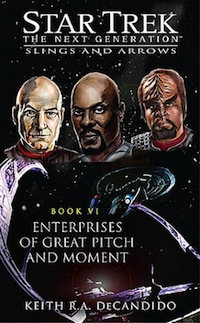
Both Slings and Arrows (particularly The Insolence of Office by William Leisner) and the short story “Friends with the Sparrows” by Christopher L. Bennett in The Sky’s the Limit dealt with the evolution of Data’s emotion chip between Generations and First Contact, including how he came by the “off switch” used here.
Some Borg technology is still floating around the Earth of the past, as seen in the Enterprise episode “Regeneration.”
The Mirror Universe version of the film’s climax is seen in the Enterprise episode “In a Mirror, Darkly, Part I,” in which Zefram Cochrane leads an assault on the Vulcan ship that lands in Montana, the first strike of what would soon become the Terran Empire.
Another version of Cochrane’s invention of the warp drive can be found in the Judith & Garfield Reeves-Stevens novel Federation, which was published two years before First Contact’s release. Another version of humanity’s first contact with the Vulcans can be found in Margaret Wander Bonanno’s novel Strangers from the Sky, published way back in 1987.
This is the last time Picard brings a woman from a pre-warp society onto the Enterprise and impresses the hell out of her by bringing her to a window. He did it previously in “Justice,” “Who Watches the Watchers?” and “First Contact.”
Make it So: “Watch your caboose, Dix.” As a general rule, I hate Star Trek movies. Trek is primarily about the exploration of the human condition, and it’s much harder to do that in a two-hour movie, especially in the post-Star Wars age of spectacle. Every once in a while you get a decent movie out of it—The Wrath of Khan, e.g., which had some powerful themes about aging and consequences of past actions, plus a superlative villain—but mostly you get high-octane stuff that barely qualifies as Star Trek. There’s a reason why you rarely see any of the movies in a list of finest Trek tales.
This movie, though, works, both as a spectacle and as a Star Trek story.
Regarding the former, one of the issues many of the Trek films have had is that, after The Motion Picture—the budget for which is the textbook definition of “bloated”—Paramount refused to commit significant dollars to a Trek film. None of the TNG movies had a budget over $60 million. Here, though, the low budget is camouflaged by having the big-budget ’splosions all happen in the first twenty minutes or so. The heavy action of the battle against the Borg carries the weight for the rest of the film, which is actually very claustrophobic and low-budget—but still tense and enjoyable.
Trek at its best isn’t about how great humanity is but how great humanity aspires to be and can be—but also that we still have flaws that we need to overcome. Picard has to go on a journey in this film, getting past the trauma of his assimilation by the Borg. Cochrane has to go through one of his own, as he’s confronted with the foreknowledge of the consequences of his little experiment, which are far greater than he ever expected.
The pacing of the movie is superb. No time is wasted, as we plow right into the action, and it doesn’t let up. Picard’s obsession grows as the film goes on, most notably in his cathartic shooting of the Borg on the holodeck. And the film has so many nice little scenes: Data calmly getting shot by Sloane, Cochrane and Troi being spectacularly drunk, Barclay fangoobering, the EMH cameo, “You broke your little ships,” and that great final moment when the aliens everyone’s been talking about turn out to be (of course) Vulcans.
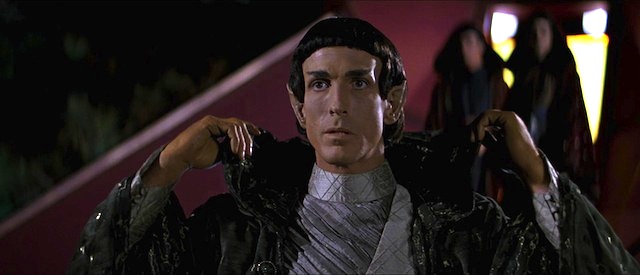
I would like to address a couple of issues that others have criticized this film for. One is the alleged absurdity of having some woman we’ve never met be the one to have the come-to-Jesus speech with Picard, that it should’ve been Crusher or Worf rather than Sloane who whupped him upside the head. But the thing is, we’ve spent years having Picard always be right, always be in charge, and the crew has come to trust him implicitly. Because he is Jean-Luc Picard, Crusher and Worf aren’t going to question him—at least not more than once or twice. It requires an outsider’s perspective to see that he’s being an ass.
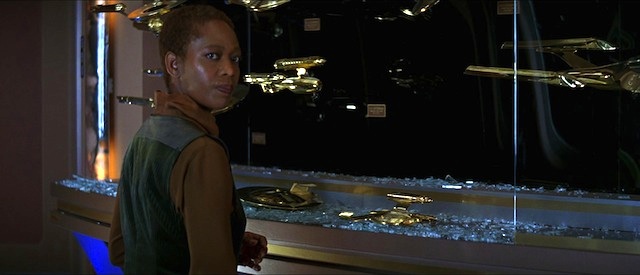
Some of the more strident fans have complained that the Zefram Cochrane of First Contact isn’t consistent with the one we met in “Metamorphosis.” Beyond the obvious—James Cromwell is seven inches taller than Glenn Corbett—Corbett’s Cochrane was far more reserved than the drunken lout of First Contact. The thing is, Corbett’s Cochrane was someone who a) had lived his entire life, much of it as the hero Cromwell’s Cochrane hadn’t become yet and b) had then after that lived for two centuries alone on a planetoid with only a giant floating omelette for company. Honestly, it would’ve been far more ridiculous for the character Riker and the others interact with to be exactly like the one Kirk met.
Not that there aren’t legitimate complaints to be made. There’s not enough for the ensemble beyond Picard and Data to do (a perpetual problem with the TNG films), and the holodeck diversion seems utterly absurd. Why not just go into the holodeck and have the computer give him a Tommy gun? Did we really need to have silly costumed drama in the midst of the ship under siege? The movie actually had some legitimate comic relief to alleviate the tension of the Borg attack, there was no need to insert that particular bit of nonsense.
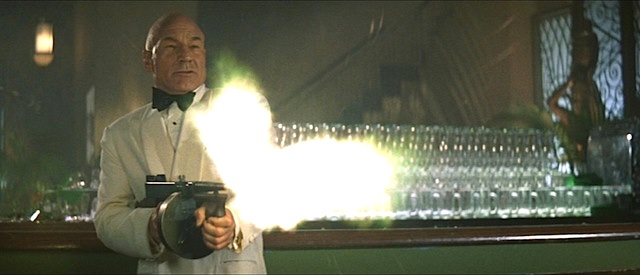
This movie has a lot in common with the second go-round for Kirk’s crew: sequel to an episode of the TV show it spun off of, resonating with Moby-Dick, dealing with revenge and consequences, and so on. But unlike the next TNG movie attempt to channel The Wrath of Khan two movies later (Nemesis), they didn’t just ape the structure of the 1982 film and hope for the best. First Contact took thematic rather than structural lessons from TWOK, and is a better movie for it.
But most importantly? This movie established the critical importance of Steppenwolf’s “Magic Carpet Ride” to the history of the Star Trek universe. That was quite possibly the single greatest moment in any of the Trek movies, one that can be appreciated by anyone who’s taken a long road trip and has to have just right tunes in the tape deck/CD player/iPod on shuffle. I still remember the absolute thrill I got in the theatre in 1996 when the song started as they took off. That, ladies and gentlemen, is how you make your first warp flight. Honestly, the whole movie’s worth it for just that crowning moment of awesome.
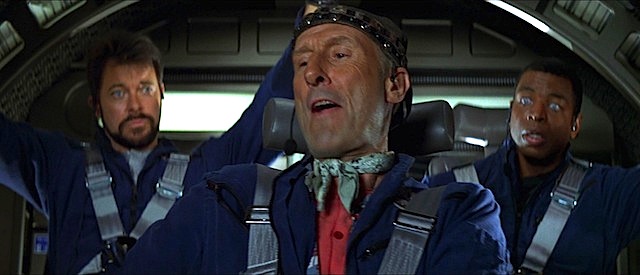
Warp factor rating: 9
Keith R.A. DeCandido will be one of the VIP guests at TrekTrax Atlanta from the 19th to the 21st of April. Miss it not! Also present will be actors Manu Intiraymi (Voyager), James Cawley (Phase II), and Ken Feinberg (Enterprise), as well asDr. Lawrence Schoen (Klingon Language Institute), Emmett Plant (Trek audio producer), the bands Il Troubadore and Go, Robo! Go!, the Merrybellies dancing troupe, drag queen Moxie Magnus, and a metric ton of folks from the various Trek fan films.










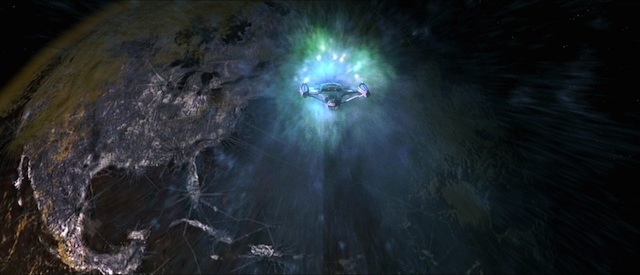
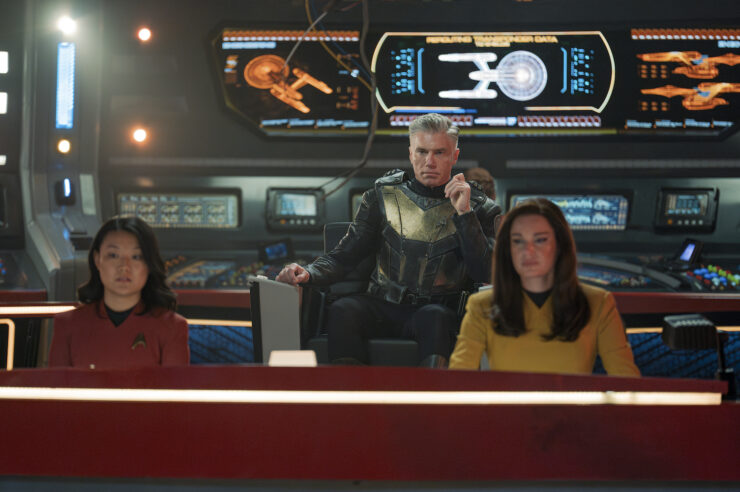
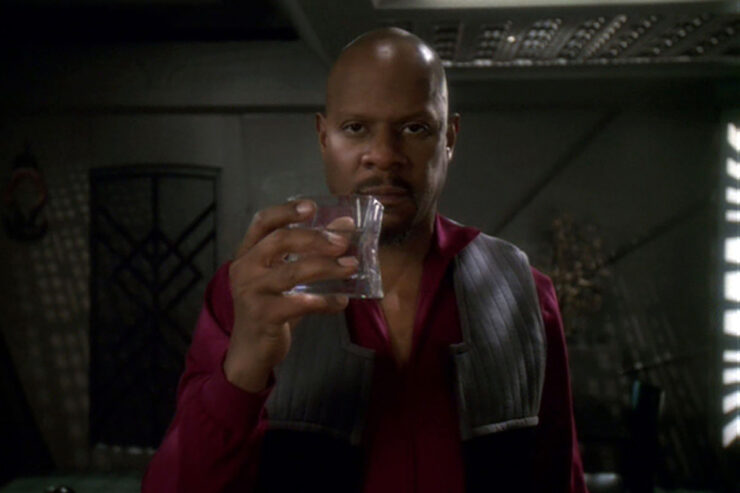

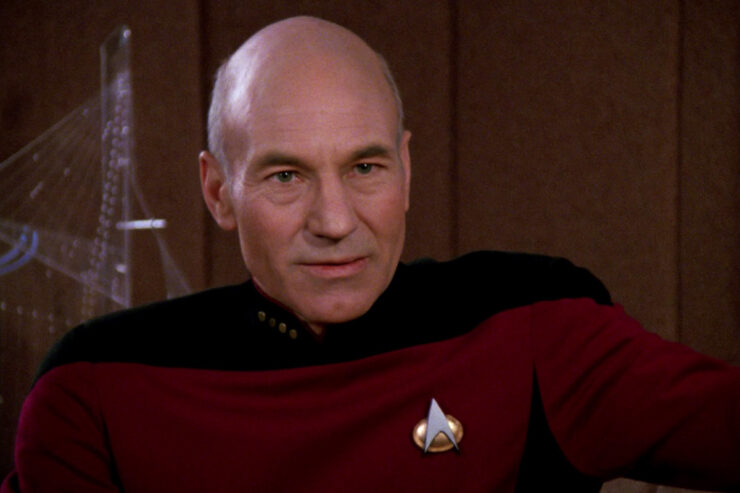
Most groanworthy quote in a Trek movie:
“You people are all astronauts…on some kind of Star Trek?”
This is the first Trek movie I saw in theaters, so it holds a special place in my heart. It’s a blast with an audience, and it works whether or not you know the characters and references.
I’d like to highlight two things about the movie that are awesome. Jerry Goldsmith’s main title theme is among the very best, equalling or exceeding the fine music that started the first and second Star Trek movies. The opening pullback shot is also quite impressive.
Another novel that connects to this movie is Engines of Destiny by Gene DeWeese. It involves the consequences of the Borg’s trip to the past being a success without Picard stopping them, and it has the Borg Queen as a viewpoint character in some scenes.
Keith, you have done an outstanding job on this rewatch. I’ve enjoyed the analysis and discussions, and I look forward to the next series of DS9 posts.
You finally lost me when you said Wrath of Khan was a decent movie: It wasn’t a good SF movie, it wasn’t a good Star Trek movie and it wasn’t even a good movie. It was an excuse to sell stale popcorn left over from Star Wars.
It’s been a while since I saw First Contact but the images were still in my head and I was able to picture most of the scenes while I was reading along. This was the best way for me to wrap up a slow Friday at work – spending a few minutes re-watching a great Trek movie. Thank you for that!
I absolutely LOVE this movie. I took my two not-very-trekky friends to see Generations, and not surprisingly they disliked it. I somehow convinced them to come see this and it set them back straight. The only TNG movie worth a damn. Patrick Stewart is awesome as a scenery-chewing action hero, and we never got to see it very often.
A few thoughts:
You mention Hawk being a redshirt. The first time I saw this movie, the moment I saw that Hawk was a new member of the bridge crew, it was obvious to me he was placed in the movie in order to be killed in action.
I love Alice Krige’s performance as the Borg Queen. I think she got it in a way that Susanna Thompson didn’t. Thompson played the Queen as if she was an individual ruling over the collective; Krige played her as the collective consciouness of the collective. A subtle distinction, and I’m still amazed by how she managed to do it.
You didn’t note the humor in how Picard and Sloane admit to each other that neither of them have actually read Moby Dick.
“with only a giant floating omelette for company.” LOL.
— Michael A. Burstein
@3 Clearly you’ve wandered in from some other fandom. TWoK was relevant to classic Trek, in the “big themes” mentioned by Keith, plus addressing the very real aging of the principals. There’s human drama, fictional technology that supports the story without being full of itself, and one of the best villains in cinema, regardless of genre. Captain Ahab, indeed.
Meanwhile, we have First Contact. KRAD, they lobbed this one to you, didn’t they? ST:FC is easily one of the best of the Star Trek films, if not the best. We have a major event in the “history” of the franchise, time travel(!), the growing obsession of Picard in giving priority to saving his ship over defeating the Borg, humor, and “Magic Carpet Ride.” If this isn’t great Trek and great Sci-Fi, just trash the genre completely, because nothing is.
Though I often wonder why an armory of traditional firearms isn’t on the ship somewhere.
@6 IIRC, not only had Picard read Moby Dick, he explained the relevent plot points and quoted from it in the Observation Lounge scene.
I didn’t like any of the TNG movies which is a shame because of how much I loved TNG. But this one is no exception. At best, I’d rank it the 4th best Trek movie after TWOK, TVH, and TUC. I think Undiscovered Country was the best about showing characters who have legitimate human failings – Kirk and his passionate hatred (understandable) of the Klingons but in the end, he overcame that prejudice to save the peace.
Picard, meanwhile, was completely out of character in this movie. We have a character who has almost always been calm and composed and he as anything but that in this movie. I’m sure he harbored resentment towards the Borg but he’d had the opportunity to wipe them out once and he passed on it. I just don’t see him acting like he did in this movie.
I thought it was a good movie, as a movie, but as a TNG movie I just didn’t like it.
Michael: You’re misremembering. Picard not only has read Moby-Dick, he quotes a lengthy passage from it. It’s only Sloane who hasn’t actually read it.
rowanblaze: I was given a choice which, if any, of the TNG films I wanted to do, and I picked this one in a heartbeat. I briefly toyed with picking Insurrection, but decided against it. I knew Emily wanted to do the other side of Generations, and they don’t pay me enough to make me watch Nemesis again. Bad enough I had to watch it when I was writing the novel (A Time for War, a Time for Peace) that set it up… *wry grin*
—Keith R.A. DeCandido
This is the TNG cast’s best film. It really is a magic carpet ride from start to finish. Its got action, adventure, and humor, probably most important of all, drawing a nice contrast to much of the dryness seen in TNG. We get to see, as Picard’s late brother Robert pointed out, that Picard “is a human being after all,” who can be overcome by the need for revenge, and pushed nearly off the deep end by it. Having Sloane talk Picard back from the brink was appropriate, as the crew sees Picard as superman, and Lily is an outsider looking in, knowing full well Picard is just a man. Speaking of being just a man, the Cochrane we see here is just that, not the superhero who changed the galaxy read about in history books. Its a great object lesson in both cases, reinforcing Cochrane’s quote of not trying to be a great man, but just a man.
I can watch this again and again over the years and still be scared to death of the Borg, who have come a long way in terms of their appearance in the film: far more zombie-like and ominous.
As far as the ensemble, I liked that those not named Picard or Data actually got important stuff to do this time round, especially Riker, LaForge, and Troi, the first two actually making the historic warp flight with Cochrane (the lift-off with “Magic Carpet Ride” playing is awesome, I agree, and the “engage” moment is icing on the cake). Jerry Goldsmith’s score here is amazing, and I have been listening to the soundtrack for this movie ever since its release in 1996.
Easily my favorite of the TNG movies, I enjoy it each and every time I watch.
My problem with this film was the basic premise of having the ST:TNG crew play an active role in earlier Trek history. Having them aboard that first warp ship *with* Cochrane just makes that history seem too “small.” (It’s like the various problems with the “Star Wars” prequels. Anakin actually *built* Threepio? Everybody knows everybody!)
Keith, you summed up the good things about the movie, so I’ll just comment on a few of the things that marred it for me.
One, the Borg having time travel makes no damn sense and is as lame and half-hearted an excuse to get the ship into the past as the handwaved historical-research expedition in “Assignment: Earth.” For one thing, if the Borg had time travel technology, surely they would’ve used it previously or subsequently to go back in time and assimilate the galaxy. I’ve heard it argued that they needed to leave other races free to develop high technology before being assimilated, and maybe there’s a point there. But if they deemed the Federation threatening enough to cull with time travel, why did they only try it once? Why was it never again suggested that the Borg had any kind of temporal capability? For another thing, “let’s go back in time and undo the formative event without which the Federation would never have existed” is just too creative for the Borg. They don’t do lateral thinking. If a problem defeats them once, they just throw more drones at it until they overwhelm it by sheer numbers. They can afford to. So they have no reason to get devious. (I tried to concoct a rationalization for this in my novel DTI: Watching the Clock. Basically someone else, a Temporal Cold War faction, was using the Borg.)
The introduction of the Borg Queen always bothered me a bit too, although I can understand why they found it necessary. The original idea behind the Borg was that they were completely impersonal, a force of nature with no individuality and no interest in individuals. But you can’t tell many stories about something like that, since stories are intrinsically personal. So they systematically found ways to personalize the Borg more — first by having them target a specific individual (Picard) and make him one of them, then by focusing on liberated drones like Hugh and Seven, and here by giving the Borg a single spokesbeing to serve as an archnemesis. I get that, I do, but it’s just kind of simplifying them, humanizing them too much.
This movie also had a negative consequence in how it affected the portrayal of the Borg on Voyager. TNG portrayed Borg drones as mostly vat-grown beings with no prior identity, as seen in “Q Who” and “I, Borg.” When they did assimilate people, it was in specific contexts; they did it to Picard so he could fill a particular role, and they assimilated the crew here because they’d lost their cube and needed to replenish their numbers. But VGR overlooked that and portrayed the Borg as a race that consisted exclusively of assimilated individuals, which is one of the biggest continuity errors in how the Borg have been portrayed in Trek. I guess that’s not FC’s fault so much as VGR’s, but still, this movie was the start of it.
And while I agree that it makes sense for Cochrane’s personality to be so different over 200 years earlier than when we met him in TOS, I nonetheless feel that Cromwell was miscast, since he was far too old for the role. Cochrane was 85 when he disappeared 150 years before “Metamorphosis,” so he should’ve been born in 2032 and been only 31 years old at the time of FC. Cromwell was 55 when the film came out.
I already said in comments to the Generations recap how much I hate the retcon about Data’s emotion chip. GEN established that he was stuck with emotion permanently and would simply have to cope with it like any human, but here they just chickened out of that character growth and started the process of undoing it, until in NEM the emotion chip was never even mentioned.
Another minor annoyance I’ve always had was Worf crudely tying off the puncture in his suit. It was a cute moment, but spacesuits of that century should’ve been advanced enough to have self-repair capability. I thought that at the time the film came out, and it was only compounded when Enterprise: “Minefield” established that spacesuits from 220 years earlier did have automatic puncture-sealing capability. (Otherwise, though, the spacewalk/deflector dish sequence is pretty well-done. At least, it’s no worse than most cinematic attempts to fake freefall — even if using magnetic boots rather than thrusters is pointlessly cumbersome.)
And yes, there is no conceivable way that Cochrane would’ve naturally put the words “on some kind of star trek” together in that order if the scriptwriters weren’t forcing him to make a lame homage. Why would Cochrane, encountering time-travelling humans on Earth, spontaneously think of them as being on a long interstellar journey? And it’s doubly annoying since Q already made a “trek through the stars” reference in “All Good Things…”, making it not only unnatural but improbably coincidental.
Oh, and one other minor problem: the big reveal at the end, that the aliens who made first contact are Vulcans, only works for people familiar with the franchise. Movies should ideally be made accessible for first-time viewers, but anyone whose first exposure to Trek was this movie would have no idea what the big deal was about the guys with pointy ears. And just as a rule, a story should be able to work without requiring reference to anything outside itself. It’s the inverse Chekhov’s Gun rule: If the gun on the wall is going to be significant in the third act, it should be seen on the wall in the first act. If Vulcans were going to be significant at the climax of the film, then they should’ve been set up in Act I. For instance, instead of Admiral Hayes, have Picard get his orders from a Vulcan admiral on the viewscreen, and have a Vulcan or two clearly visible in the Enterprise crew (maybe a cameo by Selar or Taurik).
@12: The pointy ears of a Vulcan are iconic well outside of the fandom. I can’t imagine very many people with an interest in this movie would not recognize that these are familiar aliens. Even if someone had that ignorance, it just matters for the scene in the movie that these people are not human. The reveal of what’s under the hood works to show that this is a key moment for humanity and the titular first contact with another species. It’s set up earlier in the movie that the warp flight will attract the attention of aliens, which is all a person new to the franchise needs to know.
I see where you’re coming from on some of your other quibbles. It’s definitely not a perfect movie, but it does so much well that its flaws are easy to forgive or overlook.
@12, the big reveal at the end works if you know that the pointy-ear guys are important to Star Trek. I’ve got to think that includes the majority of the people likely to see the movie! I mean, my dad can’t tell the difference between Star Wars and Star Trek, but he knows the pointy-ear guys.
That said, I couldn’t agree more with you about the dodginess of the Borg time travel scheme here. If they’re capable of time travel and know when to go, why not jump back in time somewhere in the middle of nowhere (where no one is observing you) and then fly to Earth?
Forgot to say that despite my thinking the overall plot was pretty silly, First Contact was a fun movie, probably my favorite bit of post-Kirk Star Trek.
This was the first Star Trek movie I saw in theatres and I saw it on a Saturday afternoon in a theatre of non-trekkies (and despite that, there was a totally awesome gasp by EVERYONE in the audience when the aliens turned out to be Vulcans)
One of my friends went to see this when it was released in cinemas. He had never seen any Star Trek before. I asked him how it had been? He said: “Fantastic.” So, the film appealed to non-Trek audiences and I suppose worked as a kind of cross-over.
Good script, well directed, splitting the “Riker pack” from Picard and Data’s adventure was a wonderful idea. Lilly, as has been said, worked well as the outsider who sees the situation for what it is and the only person who can convey this to Picard. From a fan point-of-view, I loved the fact that the great Cochrane was not some far-sighted, visionary genius, but just wanted to make enough money to retire to a sunny island packed with sexy girls.
A very human film. I won’t write more because I am more interested in what other people have to say. Good stuff.
@7: It is possible to be part of Trek fandom and not like TWOK. I’m not fond of it myself. There is nothing that all of fandom agrees on.
@8: The problem with the phrase “out of character” is that people who use it often mistakenly assume that a person always behaves in a consistent way. Picard is out of character here because it makes sense for him to be out of character in response to this. He was, essentially, raped by the Borg. They forced him to supervise the murder of thousands of people including fellow Starfleet officers. It was the most devastating, traumatic experience of his life, and now he was being forced to face it again. Of course he wouldn’t behave the same way in that context that he would in most others. Nobody would. The Borg changed his character by the traumas they inflicted, and while he managed to fight his way back to the man he had been, and still be that man in most cases, the changes were still there inside him, and these events drew them out again. So yeah, he was out of character. That was the whole point.
@13: Yes, Vulcans are known outside fandom, but as I said, just from a basic storytelling standpoint, it’s bad form to make a story’s climax depend on something that isn’t set up within the story itself. People know what guns are, but if a character having a gun is important at the end of the story, you should introduce the gun earlier in the story. It’s just good structure. (In elementary-school English class, one of the rules drummed into our heads was that you should never assume your audience knows something. Even if it’s likely that most of them do, you should still make it clear within the work itself.)
And yes, I agree it’s the best of the TNG movies and one of the best Trek movies overall. But Keith already mentioned all the good stuff, so I didn’t have to.
@12:
Enitely agree. The “Let’s go back and assimilate Earth” always seemed a bit “Un-Borg”. Why? Yes, you get humanity, but the Borg were usually more interested in technologically advanced species. Okay, yes, going back in time wipes out the “threat” posed by humanity. But even this seems a bit over the top. If I were Borg, I’d assimilate them at the height of their current technological advances. Besides: “If you don’t get it assimilated first time, try try again”.
I’ve read elsewhere that the main reason for the Borg Queen was to have an identifiable villain rather than a bunch of drones. Perhaps the idea of the Queen is to show that the Borg can be “creative thinkers” (she still seems to have an independent mind) and come up with some plan to assimilate Earth before the Fed gets going. Didn’t work for me, but I ignored it when I watched the movie.
With the Borgias in “Voyager”, it is no longer easy to remember what the original version was when Q introduced them so long ago, now. I do see what you mean.
Well, I could go on and debate with you your points one by one (most of which I agree this time around) but I am, as always, more interested in what others have to say.
Thanks as always for very enlightening comments.
However, I must add that I understand what you mean about the Vulcans appearing at the end and being too referenced to Next Gen TV series. I did ask my friend what he thought (the one who had never seen any Star Trek). He said: “Well, they’re bloody advanced aliens and it changes everything and humanity gets better”. So, yeah, it kind of works.
@18 I understand what you’re saying but I guess my point here is that Picard had been exposed to the Borg in several previous situations and he just didn’t act that way. But this did become more personal since they were taking his ship from him again so I can accept an argument based on what you said as far as how he was acting. But you hit on a number of things that I didn’t mention that I agree with.
Borg in TNG were my favorite villians. At least up through “I, Borg” (Awesome episode) but after that they struggled to use them as they were written so they re-wrote them. Maybe that’s fine for some people but the original Borg and even the slightly altered version in BoBW are scary because they’re truly alien. It might have been easier to humanize them to make them easier to make a villian in the movie but I feel like they could have made a movie so much more interesting.
The time travel was a huge issue that several have already mentioned since it made no sense. The Borg wouldn’t do that and if they could they’d win by just doing it again when noone was around.
But this movie significantly changed the character of the Borg and started the changes that Voyager really ran away with.
Loved First Contact, especially for the new Enterprise. The Queen gave me the creeps the first time I saw her – and still does.
My order of ranking for the TNG films is:
First Contact
Nemesis
Generations
Insurrection
Generations was, I felt, an OK sendoff for the Enterprise-D. Kirk’s reappearance in the latter part of the movie was a little odd and didn’t seem to make much sense. Lursa and B’Etor were a little annoying, though the expressions on their faces when the Enterprise entered the Veridian system and Picard hailed them, then later when they realized they would be destroyed, was priceless.
First Contact – ’nuff said.
Insurrection is the weakest of the lot for me. The Son’a and the Ba’ku the same race? A Federation Admiral is collusion with the Son’a? (They did keep their true past from him, but still …) The only thing I found even remotely funny was Riker’s line “I intend to shove it down the Son’a’s throat.” And don’t get me started on Data’s comments to Deanna and Beverly during the evacuation – those are the most cringeworthy lines in the entire movie.
Nemesis. A lot of people have heaped scorn on this movie, citing it as the even numbered film that broke the Star Trek curse. Certainly it has its weak spots and plotholes – the mystery surrounding Shinzon looming the largest. As Beverly said to Picard, the aging process for Shinzon never kicked in, so in Nemesis he appears to be around 25 years old, give or take a few years (I’m inclined to think he might be older than 25, because I seriously doubt a teenager could have fought so successfully in the Dominion War, but who knows?). That means that he would have begun his existence anywhere from the early to late 2350s, well before the Romulans reestablished contact with the UFP in “The Netraul Zone.” Clearly, Romulan operatives had to have been working within the Federation between the Tomed incident and 2364, and the Federation High Command never caught on? B-4, too, was another unexplained plothole. How did Shinzon acquire him?
For all its flaws, though, I thought Nemesis an excellent movie – a step below FC, to be sure – but still a good one. The flashback scenes of young Shinzon in the mines of Remus, Picard’s internal struggle over whether he might have turned out like Shinzon, the battle in the Rift , the destruction of the Romulan Senate (gruesome without being too scary), and Picard’s realization in his ready room that Shinzon could not be saved were all brillant moments in the film. Then, of course, we have the climax – the loss of Data. *sniff* I still can’t believe they did that.
@rowanblaze
“TWoK was relevant to classic Trek, in the “big themes” mentioned by Keith, plus addressing the very real aging of the principals. There’s human drama, fictional technology that supports the story without being full of itself, and one of the best villains in cinema, regardless of genre.”
Amen to that.
I know this is slightly off-topic, but did anyone else think Hans Landa from Inglorious Basterds was influenced by Khan?
Y’know, the way he was unfailingly polite, well-read, charming. An all-round class act really. All of which threw his ‘evil-ness’ into sharp relief.
I know Tarantino is a Trek fan (though I wouldn’t go as far as to call him a Trekkie) so its possible on his part. Dunno about Christoph Waltz though…
I saw First Contact in the theater the night it came out, and I had a blast. It was exciting, things blew up, the entire experience was fun. But I haven’t seen it since then, and I really haven’t wanted to. I tend to put it in the same category as Independence Day and a number of other sci-fi action movies that came out about the same time: a great two hours worth of entertainment, but lacking in whatever the magic is that makes you want to come back to a story over and over again.
@20: Well, Picard did act that way in “I, Borg,” pretty much. We saw there how much his hatred for the Borg overcame his usual tolerance and empathy. And between then and FC, the only “Borg” he interacted with were the liberated drones in “Descent,” which weren’t part of the Collective anymore.
@21: I agree that Nemesis is an underappreciated movie, but I’ll get to that in about two rewatches.
@22: There have been classy, charming, debonair villains in fiction for a very long time; Khan is one of very, very many. So it seems unlikely.
You know, ever since Voyager showed “Borg Space”, I’ve always wondered why, if a handful of attacks using one cube almost, but not quite worked, why not send two cubes?
This is certainly far and away the best of the TNG movies (let’s face it, it doesn’t have a lot of competition.) However, I also have reservations about the Borg having a Queen. It just seemed to take away some of the menace rather than adding to it. Having a whole race that thinks and acts as a single personality, that will willingly walk into death because each individual is only a small part of the whole, was impressively “alien”. Having a single entity in control of it all diminshed that in my eyes.
My other thing with this movie, and this may be an unpopular view (I honestly don’t know), but I never liked the look of the Enterprise E. It always looked to me like something a 12 year old would come up with. Obviously computer graphics had allowed them to do things with the ship that model shots couldn’t, but the models looked like proper substantial ships of a functional kind. The E just looked like the “boy racer” version.
@25: The thing is, Borg space is very far from Federation space — and it’s huge, encompassing a massive swath of the Delta Quadrant. Imagine how extensive the borders of such a territory would be, how many other civilizations the Borg would constantly be invading or fighting — some of them, surely, equal to or beyond the Federation in technology and power. So most of their resources would be spent battling foes closer to home. The Federation was so far away that it wouldn’t have been very high on their list of priorities — more a curiosity than a mortal foe. (To paraphrase a line Raul Julia once delivered, “For you, the day the Borg invaded your space was the most important day of your life. But for us… it was Tuesday.”) So it wasn’t important enough to justify sending more than one cube.
Although, now that I think about it, that does raise the question of why they’d send what was apparently their one and only time machine to deal with Earth…
@26: I never thought of the Borg Queen as being an individual who controlled the Collective. I just thought of her as sort of a central processing node for the collective mind. After all, we did see another Queen emerge after this one was killed, and that Queen was killed in VGR: “Dark Frontier” and then replaced. So the Queen isn’t a specific person, just a specialized type of drone. The individual bodies are interchangeable, but they plug into the same role in the overall system, like swapping out an old circuit board or hard drive for a new one. In the novels, the Queen drone contains programming called the Royal Protocol, which serves to focus and direct the activity of the collective mind and give it a will — sort of like the role the frontal lobe plays in the brain, IIRC.
I quite like the Enterprise-E. And FC used both physical and CGI models for the ship, making it the last Trek film to use a physical Enterprise miniature. In particular, the physical miniature was used in the spacewalk scene because at the time it was still easier to get intricate close-up detail on a physical model than on a CGI one.
I thought Picard’s tommygunning the Borg, though admittedly silly, was equal to the Magic Carpet Ride moment on the awesome scale. But then this movie has quite a few of those moments. Despite some goofy bits of dialogue and the typical time travelin’ lapses in logic (hey, when has a time travel movie not had those?), it’s an entertaining Trek to the Future… I mean the past… I mean… ah, forget it.
In defense of the holodeck episode (and pretty much off the cuff), I can think of two arguments. On a plot/character level, I see it being used to portray how deeply the Borg have penetrated into Picard’s psyche, leaving no aspect untouched by the violence and rage, not even his ‘light’ love of noir ‘tec novels and dressing up to play around for an hour. As for the practical aspects, he could just conjure up a tommy gun, but that would still leave him in an empty room with x number of Borg coming in—he and Lily would be unguarded targets. By using the ‘chapter’, he’s choosing a battleground that gives him familiarity, cover, and camouflage—a tactical advantage.
re the one and only time machine
I doubt the Borg invented the time machine. So maybe the cube was sent for a more mundane attack and it assimilated the time machine on the way. They then adapted it to their existing tech and formed a new plan of attack. Then, the cube was destroyed so they couldn’t take it back to the Collective. (And the schematics weren’t emailed back home first because, uh, distance.)
I saw this in the theater, I think about six months after I first got into Star Trek. So it was a very big moment for me. I think I had seen Generations on tv a little before that, so I knew about the new ship and everything. But I remember even getting very excited about this even before the release. I hadn’t seen much (or any) DS9 so Quantum Torpedoes were this awesome new thing to me (and I think I though the Defiant was a runabout for a while). I thought this movie was totally awesome.
In regards to the music, I think they ended up using the theme for the Olympics. While I was thrilled that they included both “Magic Carpet Ride” and “Oobie Doobie” on the soundtrack, I was–and still am–very disappointed that they don’t have the music of the Phoenix flying out into space and approaching the warp threshold.
I think this movie is executed well enough that it is still pretty enjoyable to me dispite the dumbness of the time travel plot. It was a thing that I was really into and accepted at the time, but in growing older, I’m kind of like, “Really? Another Star Trek time travel plot?” And yeah…it doesn’t make a whole lot of sense. But at that front, perhaps the Borg has its own version of the Temporal Prime Directive–maybe the Borg knows how dangerous time travel can be. I get them impression that you could view the time travel plot as a last resort if you want to–they originally came to assimilate Earth in the present, but had the time ship as a last resort. But I’m interested now to see how this issue is dealt with in Watching the Clock. In any case, I was reimagining the scenes of this movie while reading the recap and getting very excited and nostalgic.
I think the discussions of the evolution of the Borg are very interesting. It kind of seems like there is a process akin to Flanderization going on here, but the likeness only goes so far as that the characterization changes to fit new perceptions of what the Borg is (not necessarily just reducing the Borg to/magnifying a trait exhibited before). I’m speaking primarily of the assimilation thing here: When it happened to Picard, it did seem like a unique behavior, and then it just became something the Borg does. Too many cooks in the kitchen, I guess. But I happen to think that that particular characterization of the Borg is a pretty effective one. Also, I think we have to see the Queen as a manifestation of the collective conciousness (“I am the Collective”) rather than a leader, and this conciousness can interact with individual’s via a specialized drone body. But I also think people inherintly tend to change concepts to fit their own understanding (taking a concept like a collective conciousness and giving it a “hive” leader). I think this later tends to become part of the accepted definition of the construct. Originally, I get the impression that a drone wasn’t meant to be like a worker bee, but more like a finger or other appendage.
I was never a big fan of TNG. Do you remember that episode where Piccard could have wiped out the Borg using a sor tof computer virus but didn’t, in order to save a single Borg who gained self-awareness? I always felt this was the moment TNG lost me. A military leader should sometimes make terrible, difficult decisions to serve the greater good, and the type of do-gooder moralizing that TNG exhibited at the time felt wimpy and childish, like somehting you’d see on G.I.Joe or Transformers – not something you’d expect to see on a grownup show. TOS never felt that lame to me. One more thing I hated about TNG was that their culture only included classical music, classical novel, classical plays, and at best they’d have a 40’s style holodeck adventure. Where was the rebeliousness? where was the counter-culture? where was rock’n’roll? TOS at least had miniskirts and “future” music and games, and these guys were immersing themselves with centures-old media, while wearing silly looking Pajamas.
Now, in ST:FC, Piccard’s lines and actions were completely out of character – sudenly he’s a tormented, driven, ruthless leader which he never was. There was rocknroll and drinks and sexiness. The uniforms were cool.And there was the 2063 croud to poke fun at every TNG convention.It didn’t feel like TNG at all. I loved it.
In a sense you can see the glimmering of what was going someday to be BattleStar Galactica here.
I considered this movie to be a diaster, for a long list of reasons, but the most critical was that it cemented the ridiculous idea that the Borg have a centralized command structure in the form of the Queen. *That is not how hive organisms function.*
The whole point to the Borg was that they had no centralization at all. Each unit was anonymous, interchangeable, and replaceable to the point of expendable. With insects, the ‘queens’ are not rulers or representatives – they’re gonads, fully interchangeable and replaceable, and bee queens will in fact be killed by the workers if they cannot fulfill their functions or even merely cease fully responding to chemical cues from the rest of the hive. With the Borg ‘Queen’ we’re given a warmed-over and stupid misunderstanding of what a queen is and does – and more to the point, her existence means that the Collective made their entire societal and technological structure meaningless merely to introduce a potentially fatal weakness into the design. Even starships are set up so that the loss of one person, even a captain, does not prevent the ship from functioning or fulfilling its mission; yet the Borg all cease functioning when the Queen is destroyed? Lazy writing, shoddy thinking, and a terrible degredation of a once-terrifying nemesis. It’s a shame Alice Krige’s excellent performance was shackled to the moronic scriptwriting.
This is a problematic movie. While the pacing is great and it is a lot of fun, what it did to the Borg was unforgiveable. The Borg Queen ranks up there with one of the worst story decisions ever made. They took a species whose primary strength was its decentralized nature and replaced it with a single point of failure. At that point it was simply impossible to ever be afraid of the Borg again; they were a joke.
I understand why they did it. The Borg were simply too powerful. You could not make them a reoccurring enemy on Star Trek without completely nerfing them. But this was simply lazy writing. And it lead to the ridiculous overexposure of the Borg in related series, like Voyager.
My post #34 seems to have been eaten by an overzealous spam filter, so I’ll try to reconstruct it.
@31: What you suggest couldn’t work, since the Borg are a collective consciousness. What one of them knows, all of them know simultaneously. The drones aboard the E-E needed the deflector dish because they’d lost their cube and its vinculum (subspace link to the rest), but while the cube existed, it would’ve been in constant contact with the Collective.
@32: There was a complete FC soundtrack released a couple of years ago. It should still be available.
@33: Picard didn’t do it just to save Hugh. He did it because he realized that drones were not monsters but enslaved victims of the collective mind, victims who deserved the chance to be freed. You don’t fight slavery by killing the slaves. Not to mention that, as FC itself proved, the “infection” that Hugh spread only had a finite impact, apparently just affecting Hugh’s cube. No doubt the more destructive program would’ve been blocked by the same antivirus defenses. All he would’ve achieved was to murder one population of drones for no reason, because it wouldn’t have stopped the rest.
Not to mention that Picard isn’t “a military leader.” It was frequently made clear in TNG that he considered himself an explorer, not a soldier as Kirk did, and was uneasy with the military side of Starfleet. The character was modeled on Jacques Cousteau and named in honor of pioneering scientist-aviators Jean and Auguste Piccard.
Moving on:
@35: But destroying the Queen is only a temporary setback for the Borg, since they just install another. It is contrived that they always need a female drone for that particular function, though. (Though I have a theory that Seven of Nine was intended as a potential replacement Queen body if something happened to the current one. She was stored in a special alcove near the heart of the cube she was on when we first met her, which might suggest she was being saved for something. And she always seemed to have more individuality and will than a normal drone, even before she was separated from the Collective.)
Time travel was really popular at this point in the Star Trek franchise. This movie, “Trials and Tribble-ations,” and “Future’s End” were produced and released very close together.
No wonder there’s a Department of Temporal Investigations.
@37 not sure what happened to your original post, but the comment at #34 is legitimate spam (hair restoration, this time, in case anyone was curious).
@39: There’s a certain level of irony in that, TBH.
@39: That’s bizarre. I know I submitted my post after #33 and before #35, so why wouldn’t it have shown up? Is it possible I submitted it at the same moment as the spam and it got kicked out somehow?
@41: That could be (not that I know how the system works). I once observed two posts on the rewatch that were posted at the same time, and the numbering was out of order (ie, the first one to show up had a higher number than the next). So perhaps it’s possible that something similar kicked your comment out too? Or perhaps our gracious moderator is implying the hair comment was manually deleted…in which case…I’m not even sure why I’m trying to answer this.
First Contact was exciting but to me it did for the TNG cast what The Voyage Home did for TOS cast. But this installment ranks number four on my list.
My only comment is that it’s amazing how the episode guide style pioneered by “Doctor Who: The Discontinuity Guide” (Cornell/Day/Topping, 1994) has become *universal* for *anyone* reviewing old episodes of *anything*. Including this one.
I suppose it must be a useful review style. I’m getting nostalgic for pre-1994 review styles, though.
@41: Your guess is as good as mine, unfortunately–the spam comment showed up at 3:32AM, if that helps. There’s no other comment trapped in the spam filter (otherwise I would have published it earlier, which is why I initially mentioned it). Odd.
@46: I suppose it’s conceivable that I hit “Preview Comment” instead of “Quick Reply,” mistakenly thought I’d posted the message, then closed the window and lost it. That seems unlikely, but I can’t rule it out.
If you haven’t seen it yet, type in Star Trek First Contact Red Letter Media into youtube. You’ll never look at the movie the same way again. I want some pizza rolls!
I admit it. Everytime I watch it a tiny tear escapes my eye when the Vulcans walk out of the ship.
The Defiant helmsman is played by Adam Scott, currently a regular on Parks and Recreation, where his character has been heard to argue about Kirk vs. Picard and other Trek matters.
Why just one cube? The Borg are all about efficiency (Seven was always on about it.) They send one cube to Earth; it fails. They send one cube and a time-travelling sphere to Earth; that fails. They send many thousands of cubes… well. The minimal losses they suffer in this movie and in BoBW don’t bother them any more than we’re bothered by losing skin cells every day.
I just rewatched this movie myself for First Contact Day (negative 50 years!) and it’s still my favorite of the TNG films. The bar is low, of course, but what I particularly like about it is that it’s not the villains who are revenge-crazed this time, but Picard. The beats of his arc are well-executed, with the audience being a step ahead but wondering just when and how he’ll realize how he’s behaving.
And I’m glad they didn’t move on to the Enterprise-F. The Sovereign is one of my favorite starship designs.
@50: Ha! Glad you celebrated First Contact Day! I thought about posting something like, “50 years until the Enterprise-E gets here” on my facebook (on the 4th) but I didn’t. I still wonder if there’s going to be a big party in Montana when the actual First Contact Day comes.
Another point to add to the “why just one cube?” question: A Borg cube is not just a ship, but is comparable to an entire fleet. Reputedly, a single cube is powerful enough to assimilate an entire planetary civilization (although that doesn’t really make sense from a scale perspective — where does it keep all the people and technology it scoops off the surface?).
On the Music. it is great. A local youth sympony orcestra had contact with the composer and was allowed to perform the origional studio material. the problem… Studio material, especially for movies, does not tend to be complete works. Rather much of it is only bits and peices that are edited together, so the director of the youth orcestra had a blast peicing together a musical jigsaw puzzle from the music sent to him, sometimes no more than a few bars at a time, then edit it so each of the themes works in the same peice of music.
I don’t really like this one. I saw it in the theater and haven’t seen it since. Didn’t like the Borg queen, or that girl following Picard around and always yelling at him. The Borg seemed more like zombies walking around. And the whole time travel thing… yeah. When they were caught in the wake and seeing the effects of the Borg in the past, I was struck by the idea that stuff the Enterprise crew would do would create changes, like a suggestion to turn around would suddenly change their sensor readouts.
I did go to the Red Letter Media homepage a while ago and checked out their review. That guy hand some pretty funny comments “Did I mention the Defiant was designed to fight the Borg?” and “Why is the flesh dissolving plasma behind breakable glass?” Also, his analysis of the final discussion between Picard, Data and the Borg queen in pretty great. Someone will say something, then that point will be agreed to then completely forgotten moments later.
@54: That reviewer must not have been aware that Data is far stronger than a human. The plasma conduit wasn’t “breakable” to anyone but him.
This movie and especially Nemesis didn’t feel like Star Trek to me at all — it felt like they were wannabe Alien movies that were pushing for action and explosions rather than the cunning and diplomacy TNG became famous for.
I thought Generations felt much more like Trek to me. And I thought that movie was merely OK.
Watch this Youtube clip I found. This is what happens when movie studios do not use the same writers as those who wrote on the original show.
I am the kind of person who has an eye for fine detail and this kind of stuff really turns me off.
http://www.youtube.com/watch?v=WkLxFLOW9ew
@57: Continuity glitches happen even within a single show with a continuous writing staff. Or even in a single series written by a lone author. There are several notable continuity errors in Doyle’s Sherlock Holmes canon, like Dr. Watson’s war wound moving between his shoulder and his leg. You can find continuity errors or retcons in just about any long-running series like Niven’s Known Space or Asimov’s Robot/Empire/Foundation universe. Some authors don’t even bother with continuity; all four of Arthur C. Clarke’s “Odyssey” novels beginning with 2001 are differing interpretations of the universe.
After all, writers are human too, and that means that not only are their memories no more perfect than anyone else’s, but sometimes they deliberately change their minds. Not to mention that a TV show’s writing staff can change over the course of its run. Most of the Trek shows had a lot of changes in their writing staffs.
I will always love Nemesis for introducing me to Tom Hardy. This one was ok, I enjoyed it more than Generations, which felt like a whole bunch of fan service strung together by a flimsy plot. I’ve always loved time travel stories, Voyage Home is favorite TOS movie.
Quoth CounsellorDeannaTroi#1Fan: “This is what happens when movie studios do not use the same writers as those who wrote on the original show.”
I find this quote amusing, given that the first two TNG movies were written by long-time TNG staff writers Ronald D. Moore and Brannon Braga and the third was written by the late Michael Piller, who ran the TNG writers room for 5/7 of its run. :)
—Keith R.A. DeCandido
And it has always bothered me that the first contact was with Vulcans instead of the Andorians, as had been previously established in the “extended universe” mythos created between TOS and TNG.
I suppose it’s just another example of an alien race from TOS slowly being eliminated from the primary canon merely because it looks ‘silly’.
@61: Star Trek has never had a single consistent “expanded universe” continuity the way Star Wars did. Different tie-ins have proposed different versions of events. And as far as I know, only one novel, Spock’s World, ever claimed the Andorians were humanity’s first contact. In fact, the 1980 Star Trek Spaceflight Chronology, which was used as a template for a number of ’80s novels, claimed that first contact was with a race of humanoids native to Alpha Centauri. See, because Zefram Cochrane was said to be “of Alpha Centauri” in “Metamorphosis,” a lot of fans concluded he was an alien, even though there were numerous other references in the episode explicitly establishing him as human. So the theory arose in some tie-ins that there was a very humanoid race native to Alpha Centauri, or perhaps humans transplanted there by aliens in antiquity. Whereas other tie-ins portrayed Alpha Centauri as a human colony founded by Cochrane and others, the interpretation that’s subsequently become canonical.
The SFC’s version of history was referenced in the giant novel Strangers from the Sky, although it “revealed” that there was an earlier, secret first contact with Vulcans, a premise that would show up in somewhat different form decades later in Enterprise: “Carbon Creek.” But when Spock’s World made its own reference to the same SFC-inspired backstory, it replaced Centaurians with Andorians — and though I don’t know for sure, I’ve always assumed it was because the folks vetting Trek novels at the time rejected the native-Centaurian idea and demanded a change.
In fact, when FC came out, I remember hearing a lot of fans saying that the big reveal at the end was an anticlimax because they already knew from Strangers from the Sky that first contact was with Vulcans.
@61,
“Extended universe” is not primary canon. See Memory-Beta.
(No offense to all the authors here; novels are certainly fun too. ^^)
You know what bothers me about this film. Keep in mind that I love it. Looks great. Great action. Good stories. Strong performaces. But……..
..they turned the Borg into space bees. sigh.
Bees! My god.
I fully understand why they added a queen. And even agree with the decision. Expecting the audience to understand a villain that is just a disembodied voice wouldn’t be good. But I don’t have it in me to be afraid of bees. The Borg were terrifying as a colletive. Everyone member just a tiny, insignificant part of a much larger whole. But now…bees.
I think Chris above had some good ideas that could have worked. I think intruducing her a bit later as an alternative form of persuasion would have worked. And not having Voyager run with the queen thing the way that they did. Oh, and not having Picard say “Oh, I remember you….now.”
I wonder if Borg honey would go well with meatballs.
@64: Honey and meatballs???
It’s a Borg delicacy.
Holy honey and meatballs, Batman!
But would Captain Picard take Borg honey in his Earl Grey?
Kato
Honestly, I have no idea why I even like this movie. There is so much wrong with this movie it’s not even funny. Why would the Borg go back to that point and not before when humanity could do absolutely nothing? Okay, perhaps it’s for the tech, but there wasn’t much. Why is Picard JUST NOW getting all “Hey, I hate the Borg so much!” when he’s not only interacted with them since Best of Both Worlds but had something of a therapy session in “Family”? I know it wouldn’t be enough to overcome that grief and shock, but it kind of cheapens what happened in that awesome episode that explored his humanity when suddenly he’s, Patrick Steward, action star with a point! I hated it. Why would Data unlock the Enterprise’s computer system and actually fire on the Pheonix just so he could say “Resistance is Futile” to the Queen? Isn’t that a big damn chance to take with history just to utter a one liner? I still enjoy this movie. It is claustrophobic, it was made well by Jonathan Frakes, but it’s just a really long silly ass episode that doesn’t make much sense. None of the TNG films are really worth anything, in my opinion
I thought the Queen was played very well and her character was pretty cool and yes, I too understand the need for her in the film from a storytelling point of view because otherwise it’s space zombies (as cool as the idea of the Borg are). But, really, I can’t stand the Queen. She weakens the collective with her Individuality. I know this is about the movies/shows but, in the books, and no offense to any of the Trek writers here, I thought some of the books were just silly with the creation of the Queen through a jelly-like substance secreted by the drones. The Queen being made (SPOILERS FOR BOOK READERS AHEAD) with Janeway and that HUGE ship and it’s eating of Pluto. The novels nearly jumped the shark in my opinion, until the Destiny trilogy (or quadrilogy if you want to count KRAD’s Singular Destiny in there)
I’m perfectly happy to count A Singular Destiny. :)
—Keith R.A. DeCandido
Well, if you’re going to count ASD, you should also count my Greater Than the Sum, which was the prologue to Destiny and actually depicted the beginning of the Borg invasion. So that would make it a pentalogy. (And the word for four is tetralogy, because it’s from Greek, not Latin.)
@Keith:
I was referring more to Nemesis than anything else. I strongly disliked it because I thought it contained so many continuity errors.
This is not to say that all continuity lapses are bad. For instance,
the ongoing continuity contradictions on TV series such as “The Simpsons” (in which the time period of the family’s life must be continually shifted forward to explain them not getting any older. For instance, when the series started, Bart would have to have been born in about 1980, but that would make him 33 years old as of 2013) reflects intentionally lost continuity, not a genuine continuity lapse.
@73: Not to mention that the classic episode “Lisa’s Wedding” showed a college-age Lisa getting married in the distant sci-fi future of 2010 — and here it is 2013 and she’s still 8 years old. (And we still have live trees but don’t have androids whose heads explode when they cry.)
@62 “In fact, when FC came out, I remember hearing a lot of fans saying that the big reveal at the end was an anticlimax because they already knew from Strangers from the Sky that first contact was with Vulcans.”
I would have been one of those! I seem to recall it took me awhile to realize that it was not already existing official canon. I actually did a major book report in grade 9 on Strangers in the Sky… we had to make a large poster for our book and they were displayed in the classroom all year… mine was really, really cool…
@7′ “Though I often wonder why an armory of traditional firearms isn’t on the ship somewhere.”
Traditional firearms of which world? or century? The answer is given t hat traditional weapons whether melee or firearms are much simpler in constructon compared to “modern” tech, there isn’t need to. You need a firearm for some purpose, you replicate one on demand, and then recycle it when you’re through. The only really need is base matter for replication, and those items that you can’t really replicate efficiently or at all. (otherwise dilithium would be no more valuable than any handful of dirt)
It doesn’t really make sense that the Borg would be vulnerable to Tommy Guns. After all a slug thrower is a slug thrower, and surely, in all the worlds they’ve absorbed, they’ve long since adapted to such primitive means of offense.
@76: That’s one issue I have with the Borg adaptation thing. It’s like, they haven’t adapted to a phaser or something similar enough already? Why does changing the frequency get through before they need to adapt again? A starship’s shields can protect against a wide range of weapons, whether the ship has encountered them previously or not. Why wouldn’t the Borg have developed more general purpose shielding by this time? Why the need to adapt to every slightly different weapons strike?
@3: I get that not all Trek fans enjoyed TWOK as much as the other 99% adored it, but to slag it so completely is just “look at me, I’m a contrarian” nonsense.
As for First Contact, I agree that the Borg Queen concept was a huge miscalculation, in that it completely negated the uniqueness that made the Borg so frightening and interesting to the viewer. I did like this movie a lot, though, not as much for the plot as for the little moments that made the hair stand up on the back of my neck. Picard “the line must be drawn here”. Worf nearly coming to blows with Picard and his (“little?” and “some?” rejoinders). The drill bits boring into Data’s head. And even Crusher. During the TNG rewatch I was very critical of Crusher, in that I thought she was too often harmfully insubordinate and cavalier with her sense of duty. But when she looked at Lily and calmly explained that Picard’s dubious orders were to be carried out without question because he had earned that deference, I nodded approvingly.
Definitely my favourite Star Trek film so far, for pretty much any and all the reasons stated above.
And for anyone still wondering why the Borg turned to time travel, you should read Star Trek/Doctor Who: Assimilation².
@79: As I mentioned in post #12, an alternative (and more in-universe) explanation is offered in my novel Department of Temporal Investigations: Watching the Clock.
@80: I admit that, while the comic I mentioned does indeed allude to the reason behind the Borg’s time travel shenanigans, I wasn’t being that serious (thoughI still assert that people should check it out as it is a very good crossover).
Since you brought it up, I will definitely hunt down and read your novel, hopefully sooner rather than later.
Tumas – agreed…the comics are really good, enjoyed them very much, myself
The one part of this movie I never understood is how Lily was able to give Picard the “come to Jesus” speech. I can understand that by making her an outsider this is supposed to give her perspective, but someone I’ve known for all of two or three days isn’t going to have enough perspective on me to get me to do something I don’t want to. When Lily said “I don’t know jack about the 24th century,” my answer would be “No you don’t my dear, so STFU.” Someone from 300 years in the past comes onboard, makes acquaintances with Picard and is able to convince him to stand down? That doesn’t make any sense to me. When she says “They’re probably accustomed to your orders making sense,” my response is “My orders are my orders, this is the 24th century and you are a 21st century simpleton, not my superior, now get out or I’ll shoot you and make up a plausible excuse for Temporal Investigations when we get home”. If you would have someone give the speech, it would be Crusher, who is a longtime crew member and has been one of Picard’s closest friends for over 20 years. If she couldn’t convince him, no one else could.
@83 Iin that scene Picard does get mad at her and tries to dismiss her, and his own overreaction to that dismissal snaps him out of it, because he is self-aware enough to recognize that he is being unfair to her and that his behavior is indefensible. Seriously go watch, he acts out then he realizes he is wrong and that Lily is right.
This was on TV yesterday and I watched it; since the last time I saw it I finished a TOS rewatch, a first watch of DS9, and I’m in the midst of a first watch of Voyager, so it was fun to see the various tie-ins that I didn’t recognize the first-time through ( i.e., “tough little ship”, Vice Admiral Janeway, and Voyager’s doctor running interference with his usual brusque half-insolence).
I skimmed through the comments and was surprised to see only one comment (@11) about the thing that bothers me most about this plot – if you watch this it seems implausible that Cochrane would ever have made his warp flight when he did unless he had an engineer, first-officer, and half-betazoid counselor materialize from the 24th century to help. Did Riker and Geordi really have to actually ride-along? As the previous comment 11 noted, it just makes history seem to small, and to me it really devalues Cochrane’s amazing accomplishment. History was just re-written, and Cochrane really didn’t do it on his own…..
Many have commented on Picard’s behavior as out-of-character. I have to disagree. I think it was CLB who noted that Picard has more reason than almost anyone anywhere to be over-the-top when it comes to the Borg threat. As I’ve noted elsewhere before, I enjoy the sci-fit premise part of Star Trek, but I don’t science. The primary reason I enjoy the Trek universe is because of the characters, and Picard is a great character. His fight with his brother and cathartic breakdown at the end of “Family” is one of the most memorable scenes of the entire canon for me, and in that context his actions in First Contact make complete sense – he’s not always going to be able to behave rationally or coolly when it comes to the Borg, especially when the stakes are so high.
OK, I I think I need to retract part of my last comment. I realize the Borg sphere damaged the Phoenix and Cochrane’s setup, so on second and third thought, I guess I understand why the three from the Enterprise needed to be there to help repair the damage to allow Cochrane’s flight to take place in the same timeframe. But it still bugs me that Geordi and Riker launch with him, and seem to be coaching him like flight-instructors.
JohnC: It’s obvious that one of the seats occupied by Riker and La Forge was supposed to be occupied by Lily Sloane, but she was stuck on the Enterprise. Probably the third seat originally was intended for someone who was killed or injured in the Borg attack.
—Keith R.A. DeCandido
And perhaps Lily, or the other person who was presumabily killed by the Borg attack, one of them was the person with the most flight experience.
4 years and change after this review, I’ve just re-read it because of a comment made in the review just posted for Star Trek 2009, and I’m finally brave enough to say what’s bothered me about First Contact ever since I saw it.
Don’t get me wrong, overall, I think it’s a good movie, as far as Trek movies go, but the whole Data/Borg Queen thing makes me really uncomfortable because everyone keeps calling it a SEDUCTION, even Brent Spiner, I think, has referred to it that way, but… to me it’s not a seduction, so much as an assault, and frankly, to me, it feels like more than that; it feels really rape-y. Sure Data can (and does) break out of those restraints, but not before they’ve drilled into his head and activated his emotion chip against his will. He may have super-android-strength, but he lacked agency.
And… the skin they grafted onto him. Where did that come from? Was it peeled off his dead crewmates, or do the Borg have a really good, portable, medical-quality replicator or incubator and cloned (again, from whom?) cells.
Am I reaching? Maybe. It’s film so we only get to accept as canon what is actually SHOWN and SAID. (I think the J.M. Dillard novelization at least let us see Data making the CHOICE to go along with it, but again, in film you can’t see internal monologue), but it bothers me… and it bothers me more with every viewing (and yet, I still rewatch).
Michael Horton also played Kovin in the VGR episode Retrospect and Jack Shearer played an Admiral in VGR’s Non Sequitur but not the same as Hayes. The Enterprise-E is the seventh ship to bear that name, although FC was made five years earlier and I don’t think Star Trek: Enterprise was a gleam in anyone’s eye back then. Two stories called First Contact where Picard impresses a woman from a pre-warp civilisation – hmmm.
I’m remembering from my first run through krad’s rewatches, plural, that the first episode of DS9 with the movie uniforms (I can’t recall the name of it) had someone speak of ‘the recent Borg attack’, which… I dunno, it feels a little silly to date an episode and a movie that exactly. It gives the impression that the very day that Starfleet changed its uniform code, the Borg were sighted coming towards Earth, almost like the two were directly related.
But this is just me being disappointed that Sonnenberg’s theory was disproven by context: That the Borg attacked precisely when Sisko and Eddington were in the Badlands in a runabout. Probably wouldn’t have explained why O’Brien or Dax weren’t manning the consoles, though, but I DO like the idea that the USS Ben Sisko’s Mf’ing Pimp Hand Defiant wouldn’t head back into battle against the exact foe that prompted its creation without Captain Sisko himself unless he was caught unawares; that even direct orders wouldn’t be an obstacle for him. (Then again, he had some serious issues staring him in the face that season, anyway A Borg fight would at least ATTEMPT to distract him from the Dominion and the Maquis after all.)
Not much else to say about this one; I’d probably give it a 9 also. I had a blast in the theater, and I thought the story held up the second, third and tenth time I watched it. Plus Barclay was involved which is awesome.
Must have just assimilated a planet full of fashion designers.
Oh, that never occurred to me. Also lol.
Definitely the best of the TNG movies IMHO. It just felt very confident, moved along at a good clip, and was just a general crowd-pleaser. The Borg were the perfect baddies for the big screen and you have to remember this is before they were overused on ST: Voyager to the point of diminishing returns and no longer having that ominous undefeatable qualify to them. So it was exciting to see the Borg back in ‘96 make the leap from the small to big screen.
I had never realized it until this review pointed it out but I can fully see now how most of the budget was spent in the early part of the film with the Borg space battle but I for one never noticed it before because I was still kept intensely excited by all of the tense going-ons aboard the Enterprise. Also, the set piece of the spacewalk/deflector dish sequence was very well done and exciting.
The time travel McGuffin doesn’t really make sense and falls apart under analysis but it at least gives us an insight into an important event in Star Trek history.
Despite the good pacing, I still found myself restless during the Earth-bound Cochrane scenes. I like Cromwell as an actor and I appreciate how some of the rest of the main cast needed something to do, but Cochrane just comes across as a not-particularly amusing drunken bafoon; I was never kept in suspense that he wouldn’t complete his warp flight; and those scenes and characters just seemed completely separated from the more intense and interesting events back aboard the Enterprise as if they were in different movies. So I always found those scenes on Earth very skippable with the exception of when the Vulcans at last land in the final moments.
And then while I think the idea of a Borg queen sounds cool (like the Queen Alien in the movie Aliens), and she certainly looks cool, and Alice Krige does a great job – I honestly hate the execution and what it does to the Borg. They are much scarier when there isn’t any one individual or spokesperson to deal with (although it worked with Picard as Locutus because it was horrifying to see him turned into a Borg and used against his own will), nor speaking verbal (English) language and going on and on about perfection, and trying to act all seductive and asking Data about sex. That does not make the Borg scary to me but rather silly.
Still, a fun rousing Trek movie.
Ah, First Contact. I’ve watched this movie more times than all other 12 Trek films combined. While I think The Wrath of Khan is technically a better movie this is the one that I have to call my favorite. Part of that is because it came out when I was 9 and was the first PG-13 movie my parents took me to see. Star Trek was a big part of our household in the 90s and my parents knew I was never going to shut up until I saw this movie. And when we bought it on VHS my brother and I must have watched it every single day for a month straight.
The other part is that it’s a terrific movie. Yes it misses the tone of TNG, but the tone it does strike is excellently realized. Yes it does reinterpret the Borg into a somewhat stupider villain, and the Queen is a bad concept for them, but that’s mostly because Voyager went and made it all worse in retrospect. Yes the time travel is an odd choice on the Borg’s part, but none of the flaws matter to me because it is incredibly well-made and is a ton of fun, with a better handling of its themes than all the other TNG films and half of the original ones.
Regarding that time travel plot, by the way, my headcanon is that it was only possible because the Sol system has some unique temporal instability that the Borg could exploit only in the vicinity of Earth. Think about it: “Assignment: Earth,” “Time’s Arrow,” “Little Green Men,” “Past Tense,” “Future’s End,” every trek show has someone traveling back to Earth’s past either on purpose or by accident. We’re a hotbed of temporal screwups! I figure the Borg couldn’t create their temporal vortex until they reached Earth and even then it was plan B in case a good old-fashioned invasion failed.
@9 @krad Any chance you could share a quick off-the-top-of-your-head warp factor rating for the other three TNG films? I’m okay with just the first numbers that pop into your head (For example, Nemesis: 0?)
I covered Generations as part of my original series rewatch:
https://www.tor.com/2017/06/27/star-trek-the-original-series-rewatch-star-trek-generations/
As for Insurrection and Nemesis, I’m not sure exactly, given how long it’s been since I’ve watched either one, but I’m fairly certain neither would get higher than a 5.
—Keith R.A. DeCandido
@97 @krad Oops, I missed that review of Generations somehow. Thanks
This is a great movie and they captured the spirit of TNG pretty well. Compared to TV shows, movies need to have an epic plot, need to appeal to a mass audience, need great guest stars and need to have thematic depth. This movie has all of that. Of the 4 movies, it captures the ensemble feel the best (yes, Dr. Crusher and Troi still get screwed) and the A plot/B plot structure of many episodes. It even has Barclay in it and DS9 and Voyager cameos, reflecting the other facets of the Star Trek universe at the time. The writers were also smart enough to have Lily as a surrogate audience character. So for newcomers, when she says “What’s the federation? What’s the borg?” then Picard answers those for the audience.
And it ends with a Roddenbury-ian ending about first contact with Vulcans and humanity finally taking its first steps into that utopian future of peace and hope.
It sucks that Insurrection ended up being such a dud. I can see their thinking. Since First Contact was done by Trek veterans (written by Braga and Moore with Frakes directing) they decided to do the same with the sequel (written by Pillar with Frakes again directing). If you read PIllar’s book about writing the movie, it seems like neither he nor anyone else involved could come up with a good concept for the film, but due to the deadline to make the movie, eventually they had to just go with what they had and make the best of it. The result was not great, so for the next film they went with the opposite strategy of getting people to write/direct it who had zero experience with Star Trek. That resulted in Nemesis which killed the franchise.
@99/Tommy Tutone: “The result was not great, so for the next film they went with the opposite strategy of getting people to write/direct it who had zero experience with Star Trek. That resulted in Nemesis which killed the franchise.”
Yet they did the same thing with The Wrath of Khan, and it saved the franchise. It’s facile to equate experience with success. Prior experience with a specific franchise doesn’t matter one bit, because you can always learn. Doing research is a basic part of preparation for any new job. Harve Bennett and Nicholas Meyer watched the whole series as research before they made the movie. I’m sure the same goes for anyone hired to work on a franchise they’re unfamiliar with.
For that matter, even experience or lack thereof with the general craft of filmmaking can’t be simplistically assumed to make the difference. TWOK was only Meyer’s second feature film and Bennett’s first. And plenty of highly experienced directors and writers have put out flops. If anything, you’re more likely to find a filmmaker’s most notable successes toward the beginning of their career rather than the end. People overrate the value of experience. Often, experience just makes people complacent or gives them bad habits.
People always want to boil down the success or failure of a film to a single variable, and that’s just not how it works. There are countless factors at play, which is why it’s so hard to get enough of them to line up the right way to produce a success.
First, let me say I never liked the Borg Queens. I thought them unnecessary. (I am a bit enamored of the theory that the Queens were actually parasites on the Collective. I’ve seen that theory on one of the rewatches and elsewhere.)
However, I have to disagree with what Meledwyr has written and which I have seen in other places. Yes, queens in bee hives and other hive/collective creatures on Earth don’t act that way. However, that is the point. ON EARTH. There is no reason to postulate that hive minds act the same way elsewhere. I don’t see any contradiction that a hive mind may be centralized into a single individual, either one who literally directs the thinking of the entire Collective or which is simply the mouthpiece for the actual hive mind which is distributed throughout the entire hive.
We should avoid the conceit that everything operates as it does on Earth. Wolf-like creatures won’t necessarily have an Alpha (and yes, I know that is a huge simplification of wolf interactions and there are theories current that it is incorrect.). Cat aliens are necessarily aloof and superior, bird-aliens aren’t necessarily “flighty” and bee-like aliens may have queens (or kings) that actually direct the hive.
@101 Costumer, it’s not that the theory is incorrect, it’s only that this pack hierarchy is only seen in captive packs, not wild ones.
And I don’t get the anger about a Borg Queen either, it makes total sense to me that a hive mind would have an avatar of some sort to interface with others not of it’s hive, so I didn’t read her character as a “ruler”of the Borg. But I had missed all the Borg stuff from the show when I’d seen this movie, so perhaps it was explained differently there.
thanks again for these rewatches—they live on!
I’m sort of surprised that no one mentioned my biggest issue with this film! I’ve watched the show but never the movies, so this is my first time. I agree this was far better than Generations, and quite entertaining. The Borg Queen didn’t bother me, but I haven’t seen Voyager. Alice Krige was excellent I thought. The thing that I found unbelievable was the history. I know Trek is famously pretty vague about how the post-scarcity future came to be but the idea that in a post-WWIII civilization that basically looks like a FEMA camp Cochran managed to build the first warp engine and get it to work his first time in space beggared belief. Not to mention the idea that humans, who nearly wiped each other out—what, less than a century before?—would be brought together ‘like never before’ in a way that led to the TNG era we see by first contact. I get that Vulcans would be a moderating influence but come on.
Re Dillard’s novelisation, it’s intriguing to read it and note where it diverges from the movie. Some additional scenes, including a short exchange between Lily and a drunk hologram in the Dixon Hill scene, which doesn’t appear in the released movie but which surfaced as a deleted scene a few years ago; a scene involving “strong heart, weak stomach”, which appears in the putative ‘first draft’ that circulates online, appears here. Some padded dialogue with additional lines: in the “we have lost the Enterprise scene”, Lily interjects, “tell me more about these escape pods”. Some different ‘acting’ choices: Picard is described as “shrieking” in his “line must be drawn here” speech, and by the end his voice has become “shrill, threatening to break” – which bears no resemblance to how Patrick Stewart played that scene in the released film. And some divergences from the film, some minor (Lily’s stolen phaser is on the lowest setting, not the highest; the Defiant‘s conn officer is a woman, not a man; the Borg queen has arms) and some major: Data is almost entirely transformed into a human, and the showdown between Picard/Data/the Queen runs somewhat differently from the movie.
Does anyone here know what Dillard used or had available as resources in writing the novelisation? It was published within a month of the movie being released, so unless it was a rush job by Dillard and publisher she must have written it prior to release. I guess maybe she could have been authorised to see a rough cut pre-release? Some of the issues I’ve noted make me wonder if she had seen alternative shots of different scenes; others make me question if she had seen the movie at all, or if she was working from a script and imagining how scenes would play. Which in turn makes me wonder how many of the divergences reflect her creative choices, and how many reflect her faithfully reproducing the content of whatever script she had been given, including lines and action that would be changed by the time the movie made it onto screens.
Anyway, thought I would ask!
Marcellus: Movie novelizations are almost always written from the script. Publishing lead times are such that it is very rare to even be able to see a rough cut of the film. Of all the movie novelizations I’ve written, the only time I was able to see a rough cut of the film was Serenity, and that only because the movie’s release date was shifted six months forward after I’d already turned in the manuscript.
So Dillard would only have been working from the shooting script.
—Keith R.A. DeCandido
@105 Brilliant, thanks!
When I was 22 years old, and thoroughly steeped in the Star Trek fandom, having seen every episode of the original series too many times to count, I thoroughly disliked a lot about this movie, particularly its depiction of Zephram Cochrane, which was not at all what expected. I expected him to be the measured ’60s character from Alpha Centauri we saw in Metamorphosis. This drunk from Montana was not my Zephram Cochrane. I also thought the idea of a Borg Queen was stupid, and that if time-travel was a thing Borg could do, then they should have assimilated the galaxy a dozen times over by now. Magic Carpet Ride also did not belong in my conception of Star Trek. Finally, I thought that the Enterprise E was an ugly ship.
I still think it’s an ugly ship, but I’ve mellowed about everything else, and can now enjoy this film for the good time it is.
10 years late to this party. Haven’t seen anyone note on what my biggest beef with this film is: The crew acts very un-Starfleet in terms of having any effect on the timeline. They hide from the Vulcans, but they tell Cochrane basically how his entire life will pan out? This is a series that noted in ST-IV to have the crew take their rank insignias off their uniforms so as not to pollute the timeline. But here, they do all of that AND are riding in the ship and acting as mission controllers?
It’s a fun movie, but it kinda falls apart as “canon” if you look too close.
Much easier (especially given the terrible work on Discovery and Picard) to basically think all the movies and current TV shows are in a different “quantum reality.” At least we know that was part of the original story!
Thanks for keeping this site and old reviews going, Keith. Fun resource to look at now.
@108/Chuck: “The crew acts very un-Starfleet in terms of having any effect on the timeline. They hide from the Vulcans, but they tell Cochrane basically how his entire life will pan out?”
Keep in mind that the Borg are already disrupting the timeline, so the crew are just doing damage control as best they can. So the cat’s already out of the bag. It’s hardly unique in the history of Trek time travel stories in showing the crew interacting openly with people in the past — see Voyager: “Future’s End,” for one.
“Keep in mind that the Borg are already disrupting the timeline”
Yahbutt there’s the “Assignment: Earth” out in that “We were always part of these events.” Or you go the “Tomorrow is Yesterday” route where technobabble creates a way for no one to remember any of the interference.
Trek had this covered in other eps. They started to ignore their own rules either here or in DS9’s “Past Tense” (not sure which came first). Always bugged me that Dax walked around with her combage in the open where Kirk was specific about hiding that stuff in 1986.
Just bugged me that they didn’t follow the rules as previously set out. But I guess movies are for the wider audience who doesn’t know that stuff so it’s dumbed down / ignored.
@110/Chuck: You’re arguing selectively, ignoring the fact that “Tomorrow is Yesterday” and “Assignment: Earth” already follow contradictory models of time travel — the former posits that being in the past creates changes that have to be corrected, the latter uses a fixed causal loop model where being in the past was part of the original events. ST has never had a single consistent theory of time travel. It’s disingenuous to pretend it ever did.
It’s so ridiculous, this claim people keep tossing out that the modern Trek productions are somehow violating the sublime perfection of what came before them. I was there back when nothing existed but TOS and TAS, and let me tell you, fans were constantly complaining about all the ways those 100 episodes — or even just the 78 of TOS — contradicted each other and contained major logic holes and inconsistencies. There was never a perfect, flawless, consistent version of Trek. Hell, TOS is the most inconsistent Trek show of all, because they were literally making it up as they went. So don’t give me that nonsense about how much better things were in the old days. I was there in the old days, so I know it’s a complete fabrication. Trek back then was just as messy, just as inconsistent, just as much a mix of good and bad episodes as Trek today.
I felt Cromwell was miscast as well, for reasons entirely apart from him not being the same guy Kirk’s Enterprise came across.
Nice to see Jae pop up again!